www.bcheights.com
Chestnut Hill, Mass.
OPINIONS
Columnist Punnya Kalapurakkel discusses the fast-paced pressures of college and the value of rest.


A9

www.bcheights.com
Chestnut Hill, Mass.
Columnist Punnya Kalapurakkel discusses the fast-paced pressures of college and the value of rest.


A9
associate director of TRIO Student Support Services; Grant Gosselin, director of undergraduate admissions at BC; and Jessica Andrade, former president of CVSA and BC ’21.
The hosts also announced that each duo was required to incorporate a traditional Cape Verdean dance into their routines.
A performance by four of CVSA’s executive board members, including co-captains Lenylse Ferreira, LSEHD ’23, and Jason Dias, CSOM ’23, kicked off the show. The dancers began with the traditional Cape Verdean dance pasada, an intimate partner dance, accompanied by the slow song “Bo Tem Mel” by Nelson Freitas featuring C4 Pedro.
By LyLa WaLsh For The HeightsMembers of five of BC’s dance groups paired up with five non-dancer Boston College students to compete in the Dancing with the Scholars competition, hosted by the Cape Verdean Student Association (CVSA), on Friday night.

At the end of the event, after much anticipation, the judges voted Team Sexual Chocolate as the winner of Dancing with the Scholars. Team VIP took home the crowd-favorite title.
Alexis Silva, MCAS ’24, and Anderson Da Rosa, CSOM ’25, hosted the event and introduced the four judges: Yvonne McBarnett, director of the Montserrat Coalition; Karl Bell,
This mood changed quickly as the fast-paced song “Amizade” by Zé Espanhol heightened the energy both on stage and in the audience. With this song came new variations in the dance as partners broke apart, and each performer showcased their abilities.
See Dancing, A7
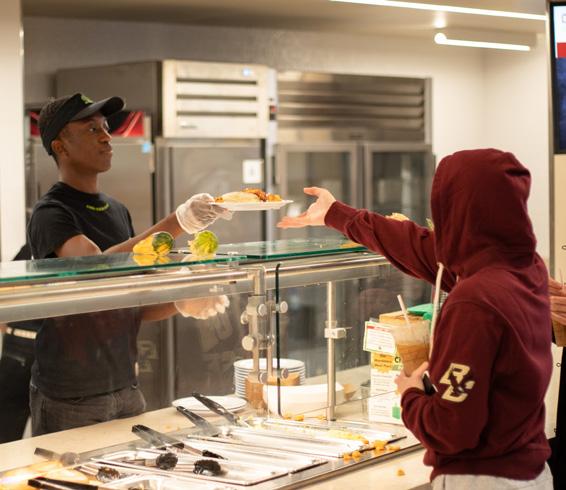
METRO
Embrace the holiday season in Newton with this winter-themed event guide. A4

A11 and A12
Zarah Lakhani said her college experience changed dramatically after being diagnosed with lymphoma halfway through her freshman year.
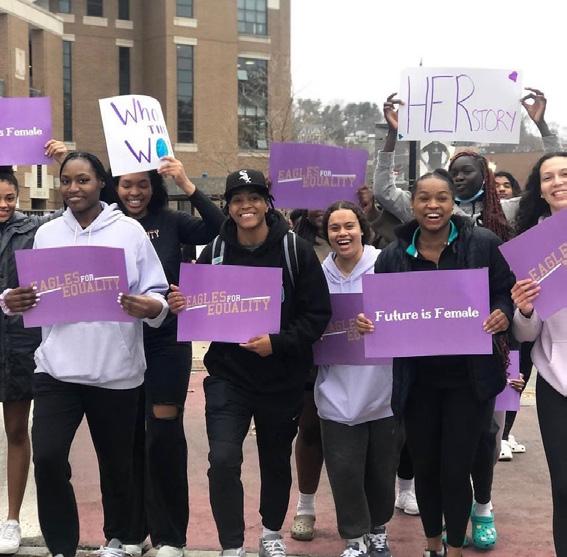
“When I got diagnosed … I got a call,” Lakhani, LSEHD ’24, said. “My dad [was] with me, and then I talked to my dad, and then like an hour later, I just went to class like right after I found out I got diagnosed. So, I was like 100 percent in shock and had no idea [what] was going on.”
After receiving her diagnosis, Lakhani traveled back home to Dallas, Texas to begin chemotherapy. She said she felt unprepared for it, which resulted in a rough start to treatment. Due to the difficult beginning, she said she was grateful to hear advice from another cancer patient who told her about different care products to ease chemo side effects, such as nausea or dry mouth.
“The thing with chemo is like, you can read all the side effects, you can
read that like you’re going to have a metallic taste in your mouth, or you can read that you’ll lose your eyelashes,” Lakhani said. “But until someone else experiences it you never fully understand the scope of the problem or the scope of how the other person feels.”
Throughout her treatment, Lakhani said she came across many products that mitigated her side effects and that she wished she had known about them earlier.
Inspired by how helpful those products were, Lakhani founded Care for Chemo, a nonprofit that crafts boxes of personal care products for chemo patients to ease the discomfort of treatment. Box contents listed on its website include Jolly Ranchers to alleviate nausea, blankets for chills, baby shampoo for scalp irritation, and other products.
Lakhani said the idea for Care for Chemo came while she was in Dallas for treatment. During her fifth and sixth rounds of chemo, she began making boxes of products that helped alleviate her post-treatment symptoms
and handed them out at her doctor’s office.
“I got just a bunch of like responses back from patients, and they were like, ‘Oh my god, we use everything in your box,’” she said. “And I was like, ‘Okay, so maybe it is actually being used.’ So, I went on to start that. I started delivering like one or two every week.”
Lakhani initially covered the 75 to 80 dollars it costs to make a box with her own money. Sometimes, this meant she was only able to make and deliver about five boxes per week. This summer, though, she began to receive more funding from individual donations and from fundraising events in Dallas and New York in partnership with Kendra Scott among others.
Care for Chemo conducts fundraising events, as it does not accept donations of items, Lakhani said. Instead, it prefers to buy new items for the boxes to ensure they are free of germs that might be harmful to those with weakened immune systems.
Cheer on Boston College as it faces Syracuse University for the last at-home football game of the season this Saturday in Alumni Stadium at 7:30 p.m.
of people to shake hands over the fate of millions of people,” Joja said.
COURTESY OF WIKIMEDIA COMMONSBoston College will now provide LinkedIn Learning, an online “skill-building platform” offered by the networking website LinkedIn, to all students, faculty, and staff.
“I think this initiative to bring LinkedIn Learning to BC is really reflective of the way in which the academic and administrative departments at BC are working together really closely to create a really dynamic learning experience for our students,” said Brian Salerno, executive director of the Center for Digital Innovation in Learning.
According to its website, the platform gives users access to over 18,000 courses in various practical areas, including professional development, technology, and design. After the completion of a course or customized learning path, the user can add a certificate of completion to their LinkedIn profile to indicate certain skill proficiencies to employers.
The University has thousands of accounts available for the BC community, according to IT training manager Jonathan McGrath.
“We have licenses for everyone at BC, so we have thousands of licenses available,” he said. “As of just a few minutes ago, and this is day two, I think about 600 something of them have been activated.”
For students, this resource will be
a major career resource, according to Associate Vice President of Career Services Joseph Du Pont.
“The employer is more and more focused on skills students have, like their competencies, rather than the specific coursework that they take,” Du Pont said. “And so this idea of you being able to build a bunch of skills at your own pace, inside and outside the classroom, is really appealing.”
LinkedIn Learning content can also be incorporated into classes, according to Salerno. Professors can add videos from LinkedIn Learning courses to their Canvas modules or encourage students to watch them independently, he said.
“Centers like the Center for Teaching Excellence, the Center for Digital Innovation in Learning, the library will very likely begin to work with faculty and reach out to them about ways in which they might utilize the content in their courses,” Salerno said.
In the long term, Carroll School of Management Senior Associate Dean Ethan Sullivan emphasized the value of LinkedIn Learning as a tool for the “life-long learner.”
“When students graduate from BC, they will constantly need to keep current and relevant in the information era,” Sullivan wrote in an email to The Heights. “Learning how to be a self-guided, life-long learner is crucial to that. Trying that out while at BC might help launch that.”
LinkedIn Learning is also a relevant staff resource, according to Associate Director of Human Resources Carolyn Donoghue. The home LinkedIn Learning page for faculty and staff features a list of courses compiled by Donoghue, which she said are meant to give these users a place to start building their skill sets.
“We tried to look at our competencies and then pick a few courses under that,” she said. “So it’s communication, team building, and management/ leadership … then once someone’s in the system, they can then go and start looking for other [courses]. We’ll update this page, and we’ll add some more competencies as well.”
BC community members can register for LinkedIn Learning using their BC credentials. Further information is available on the BC LinkedIn Learning page, which also includes a link to a form for any further LinkedIn Learning–related questions.
LinkedIn Learning will be a valuable resource for the whole BC community moving forward, according to Du Pont.
“I’m excited about the possibilities that students can tailor their learning in ways that they think are most effective for them, or anyone really could,” Du Pont said. “And the fact that you can do it at your own pace, 24/7 … we’re really excited about introducing this tool to the community and then seeing how people start using it.” n
The Russia-Ukraine conflict is unlike any war we have ever experienced since it is digitally accessible all across the world, Iualia-Sabina Joja, a senior fellow at the Middle East Institute, said.
“We see in real time on our cameras Russian atrocities, fighting, trenches, all of that,” Joja said. “It’s not possible to hide as much.”
Boston College’s political science department invited Joja to speak on Nov. 14 about the implications of the Russia-Ukraine conflict and offer projections for the conflict’s future.
Joja said the Russia-Ukraine conflict is personal for her, as she was born in Romania—a country that has historically faced significant Russian aggression. Joja’s grandmother told her about Russia’s involvement in Romania during World War II, she said, and how Russia invaded her neighborhood.
One month before Russia invaded Ukraine, Joja said Vladimir Putin “demanded” the United States withdraw all military presence from Central and Eastern Europe, tell Ukraine not to join NATO, and withdraw membership from all countries that joined after 1997—which are primarily Eastern European countries, she said.
“This is very important, because it not just highlights how Russia thinks about my neighborhood, but also the role of the United States,” Joja said.
According to Joja, President Joe Biden refused to negotiate on Putin’s terms, which excluded Ukraine from the negotiation.
“It’s just not possible for a couple
Joja said the Biden administration is driven by a fear of escalation, which Russian nuclear threats have only amplified.
In Biden’s May op-ed, Joja said he argues moving from short range weapons to medium range weapons would be an escalation in the Russia-Ukraine conflict.
Short range weapons create an impact from short distances such as two miles, according to Joja. Moving to long range weapons would create an effect for nearly 44 miles, she said.
“This fear of escalation and self deterrence is of course a lot about self perception and the perception of others,” Joja said. “It’s what we think the Russians think.”
Russia considers everything as an act of war, Joja said, such as the U.S. providing military aid to Ukraine.
Joja then offered three possible scenarios for how she believes the conflict in Ukraine will continue.
Joja’s first scenario, “freeze and repeat,” refers to Ukraine’s fear. The Ukranians are afraid of falling into Russia’s pattern of conflicts, she said, including its involvement in Hungary in the ’50s, Czechoslovakia in the ’60s, and the Cold War as well as being unable to negotiate on fair terms.
“The fear is about repeating the Minsk agreements where we will seat the aggressor and the victim at the table and say, ‘Okay. He has walked into your house, has tortured your wife, has kidnapped your kids, wants to annex the kitchen, and now please
The goal of the ImpACCt Summit is to turn imagination into reality, according to Thomas Chiles, vice provost for research and academic planning.
“What’s going on with the ImpACCt Summit, as well as what we want to do on this campus, is to imagine, make, and impact,” Chiles said. “When you imagine, you can start doing things that people before you haven’t been able to do.”
Students from four of the Atlantic Coast Conference (ACC) universities—Virginia Tech University, Clemson University, North Carolina State University, and Boston College—collaborated in teams to develop creative solutions to real-world social problems at the Design for ImpACCt Summit on Friday.
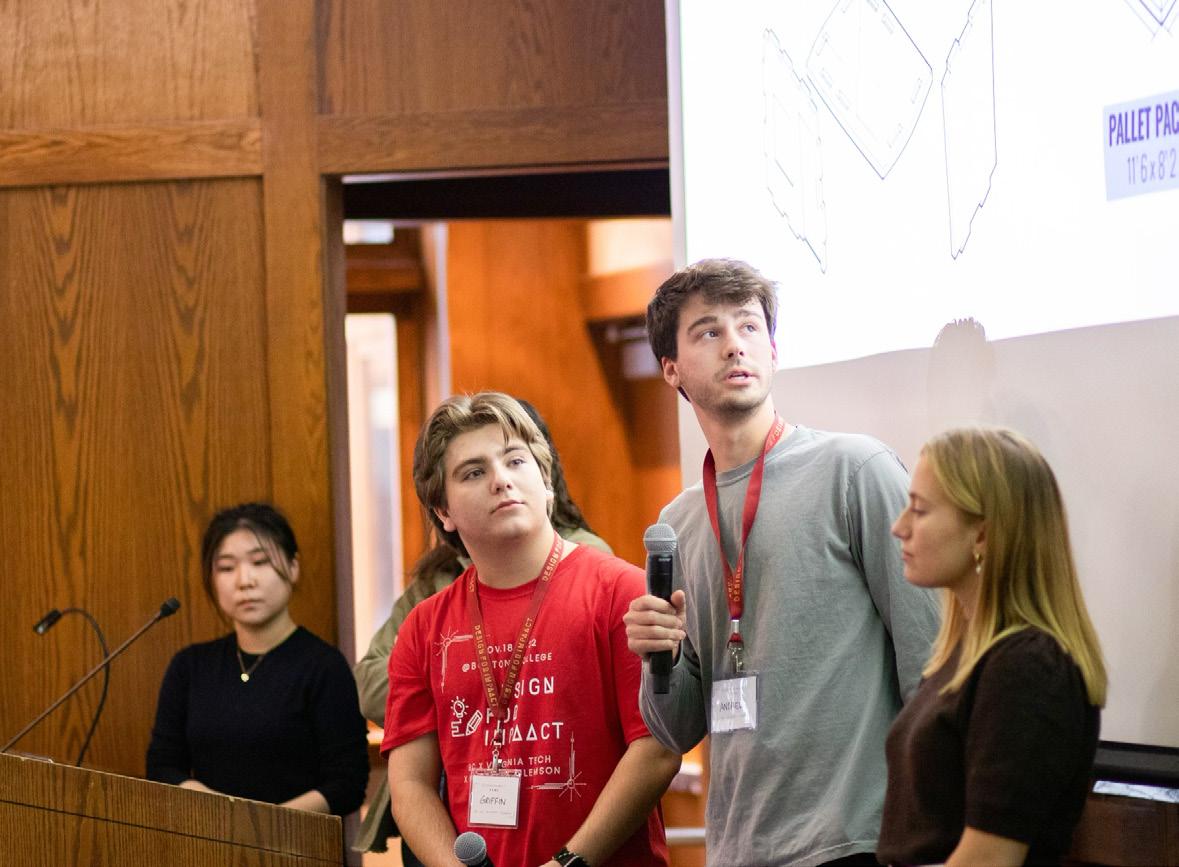
Building these intercollegiate teams is important right now, according to Sunand Bhattacharya,
associate vice provost of design and innovation strategy.

“Colleges typically compete with each other at all times, but we are getting to a point in our society where we need to break those boundaries, and this is a great example,” Bhattacharya said.
One of these teams—a group of social psychology and architecture majors—pitched Pod Connect, a safe haven resource-center designed to be implemented in subway stations.
“We hope to provide assistance to help-seeking individuals, providing an area that promotes a sense of community in subway stations, a space in which thousands of people pass through every day,” Griffin Naddy, Clemson ’23, said.
Other designs included Homesider, a home-buying app that considers sustainability, adaptability, and the walkability of a neighborhood.
“Some of the similar apps on the market were Zillow and Walk Score,
but we thought we really brought something new and interesting to the market by looking at sustainability in different aspects of the home and curating an experience where users can rank their preferences within the app,” one of the group members said.
Mickey McManus, a senior adviser at the Boston Consulting Group, said there must be an emphasis on dynamic equilibriums in design. Dynamic equilibriums include improving products that adapt to better address the issues they are designed to target. Feedback, learning, and connectivity are important aspects of establishing a dynamic equilibrium, he said.
McManus said he realized the importance of constantly improving his designs when adapting this framework toward another project, in which he structured an office’s layout to minimize distractions and improve workers’ well-being.
“This was a team of architects that were working with us to explore
generative design applied in physical spaces,” McManus said. “The idea was, once you’ve built the space, to leave the machine learning running so that it could evolve over time and make it better.”
Given the vast innovation occurring in today’s world, McManus said further emphasis should be placed
on predicting when change will come and the underlying patterns that define it.
At the end of this talk, McManus left his audience with three big
This is the second installment of a three-part series about BC Dining.
When Tania Hossain ordered the vegetarian quesadilla from Boston College Dining, she said she did not even notice she was handed the wrong one. After a few bites, she suddenly realized it had chicken in it—chicken that was not Halal.
“I didn’t know what to do,” Hossain, MCAS ’25, said. “I didn’t want to throw away food because wasting is also looked down upon in our religion … I already had a couple of bites of it too, so I just ate it. I felt so bad because obviously it wasn’t Halal.”
This was not the first time Hossain said she found non-Halal chicken in her food. She also said she found some in her customized Mexican bowl from Addie’s.
“I think the biggest issue that I have to deal with generally on a daily basis is the cross contamination,” Hossain said.
Dietary restrictions, whether they be religious, medical, or personal preference, make navigating BC Dining particularly difficult, according to several students.
BC Dining’s website states that it provides services to meet all students’ dietary needs, from nutritional counseling to meal accom-
modations. Students can also meet with the University’s nutritionist and subscribe to an allergy listserv to stay informed on BC Dining offerings around campus, according to the website.

“Each of the three dining halls offers a ‘Plain and Simple’ line at dinner which offers meals free of the top eight allergens (milk, soy, eggs, wheat, fish, shellfish, peanuts, and tree nuts), gluten, and sesame,” BC Dining Director Beth Emery wrote in an email to The Heights. “Our Administrative Dietitian is available to meet with students with medical nutritional needs.”
Other universities in the Boston area provide similar services for their own students, such as nutritional counseling at Boston University and online menus that can be filtered by dietary restrictions at Harvard University. BU differs from BC, however, in employing a fulltime director of safety and sanitation and providing a full gluten and nutfree pantry for students.
Though BC Dining trains its staff on the severity of food allergies and celiac disease, manufacturers can change product formulation without notifying BC, so cross-contact is possible, according to the website.
“Students need to be aware of risks and take responsibility for asking the manager on duty for assistance,” the website reads.
Kate Serpe, MCAS ’25, said she
approached a manager on duty after eating gluten friendly–labeled grilling grains. When her face grew flushed and her stomach began to hurt, she suspected she had consumed gluten—something she avoids because of her celiac disease.
“I went to the manager and asked if he knew if there was gluten in it,” Serpe said. “I [wanted] to know just so I could have that peace of mind knowing if I had something that was contaminated, and he had basically said that he wasn’t sure.”
Serpe said she also struggles with knowing what options will be available to her at BC when she scans the daily online menus. Even when the BC Dining website accurately lists a dish as gluten friendly, Serpe said it might not be available when she arrives at the dining hall.
“I’ll go up and ask the manager if he knows what’s gluten free for the night, and like obviously they want to make sure that everything’s safe and they want to make sure that I’m not getting sick so a lot of the times they say ‘We can’t guarantee anything,’” Serpe said.
Camryn Hughes, MCAS ’25, also stressed that nothing from BC Dining is guaranteed to be gluten free.
“Everything just says gluten friendly on it, so eating pretty much anything just gives you like a mild panic attack like every time you walk into the dining hall,” she said.
Serpe added BC Dining does offer a set meal plan option for
students with dietary restrictions where they can place orders a month in advance, listing what dining hall they would be in each day and at what time.
“I ended up obviously not doing it,” Serpe said. “It was just way too difficult to figure out what time I was going to be in the dining hall, what I wanted to eat, [and] where I was going to be every single day for the next month. It was just impossible to do.”
Hughes tried out this meal plan with BC Dining last year, but she said it was complicated and made her feel separated from other students.
“It’s really socially isolating,” Hughes said. “I think I went to the dining hall with other people like one time just because I had to go at a specific set time and I would have to go around the corner and separately pick up my food.”
BC Dining’s gluten free options repeat frequently, so it is easy to grow sick of them, Serpe said.
“I would say they have like one option per night that’s gluten free,” she said. “I would say maybe like three or four nights out of the week I just end up having the chicken and two sides because that’s what I know is gluten free and that’s what I know is safe.”
An anonymous student worker at BC Dining suggested that if BC Dining gave the chefs more freedom in choosing what they cook for students, then they could provide more creative options for students with dietary restrictions.
“The chefs, they’re good at their job,” the student said. “I think maybe if they had more liberty they could
This is the third installment in a threepart series about BC Dining.
Student outcry to changes within Boston College Dining is far from a new phenomenon. Rather, it spans several decades.
In 1977, BC Dining made the decision to require a pay as you go–meal plan system, instead of giving students the option of a 20 meals per week swipe-based system. According to a Heights article from that year, John Callahan, then-director of BC Dining Services (BCDS), said the administration instructed all departments to
financially break even, which was a large factor in the switch.
“BCDS decided to cut nonessential expenses by getting rid of the computers, used for the twenty meal plan,” the article reads. “BC rents these computers at $10,000 per year. Callahan also cited the extra man hours involved in running the two meal plans as uneconomical.”
This switch frustrated some students, with many saying the pay-asyou-go system did not give students enough dining dollars to eat three meals a day.
One student noted that every day that year, he could only afford to buy yogurt and dinner, which he said was unfair.
“You shouldn’t have to worry about whether you’re going to starve,” he said in the article.
In 2007, BC Dining slightly adjusted its structure by adding a “flex plan,”
which accommodated upperclassmen who lived in dorms or apartments with kitchens, allowing them to purchase a reduced version of the main meal plan.
Students have also consistently criticized BC Dining’s prices. In 1975, Callahan said despite the increases in food prices, the quality of BC Dining had remained the same. In 1987, students complained of “outrageous” prices at the BC grocery store, and in 2003, BC Dining attributed higher prices to student theft.
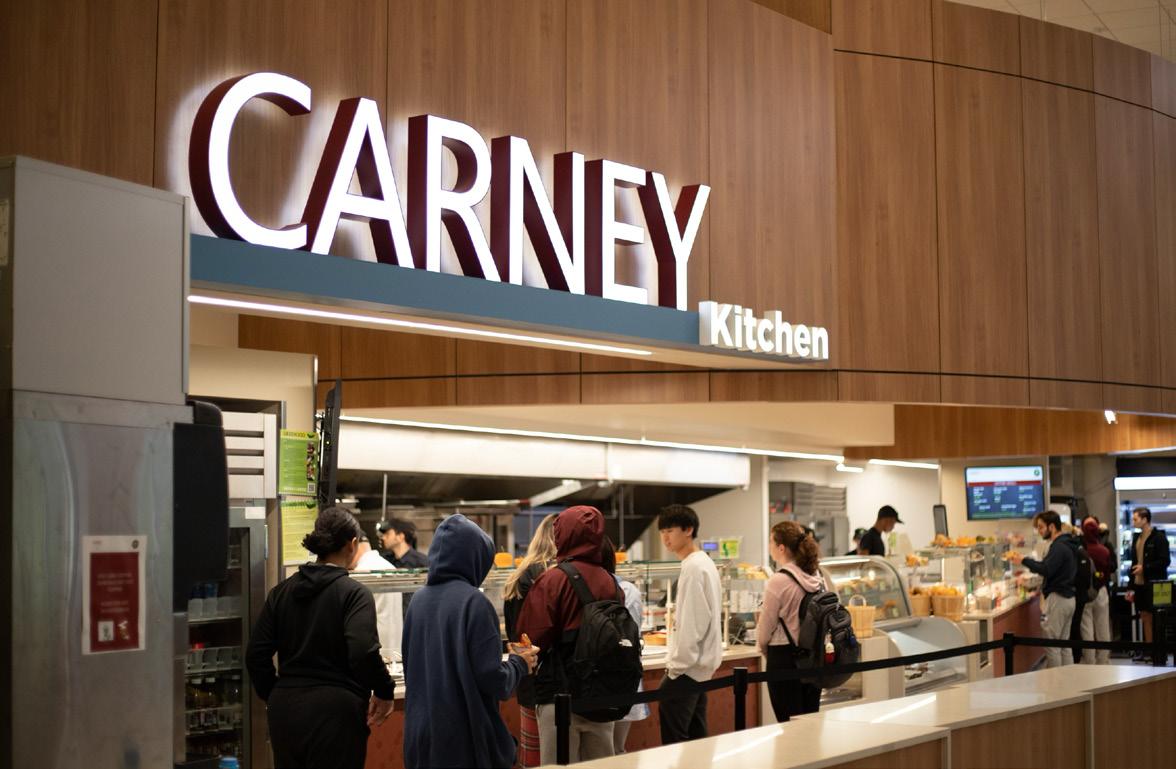
One student, who was granted anonymity by The Heights , started working at BC Dining their freshman year. Though they said it was not a glamorous job, there was an overall positive work environment—at least up until their sophomore year, when COVID-19 hit and there was a noticeable shift, they said.
“There was a big shift in leadership, and a lot of the managers changed over,” the student said. “There were a lot of changes, and it ended up being, not miserable, but messy.”
The student worker said when they switched to working at Lower Live, conditions improved. But by the end of their sophomore year, all BC Dining workers were exhausted, they said.
“Just trying to keep up with everything that was demanded of us, like the COVID regulations,” the worker said. “A lot of managers had quit that year or the year before. There was also always a lack of communication, because we never knew when certain
food was going to get here. Yeah, it was just frustrating.”
Responding to a question about the impact of COVID-19, Director of BC Dining Beth Emery said BC Dining has experienced unprecedented staffing shortages in the past two years, which impacted its operating hours and overall service.
BC Dining strives to minimize the impacts of supply chain and staffing shortages on students’ dining experiences, Emery said.
“We have experienced supply chain issues since the pandemic and managed through a difficult union strike of the drivers of Sysco, our major supplier this semester,” Emery wrote in an email. “We’ve also seen a significant increase in food and paper costs rising over 23% year over year.”
When BC Dining surveyed students in the past, Emery said over 70 percent replied they preferred the current declining balance–meal plan model as opposed to an “all you care to eat” model—or a swipe model.
“Our current model is more equitable since students who eat less do not subsidize students who eat more, and is more similar to what students will experience when they graduate,” Emery said in an email to The Heights. “In addition, students have the option to take food-to-go, use the dining hall to socialize and can have an unlimited number of guests.”
BC’s annual cost for its base man-
datory meal plan is less than most schools in the Boston area. BC’s annual meal cost plan is $6,000, while Boston University’s plan is $6,150 and Harvard University’s is $7,446.
The majority of these Boston-area universities, however, use a traditional “all you can eat” meal plan model. At these universities, including Harvard, BU, and Northeastern University, when students “swipe” into the dining hall, they can take as much food as they like. But at BC, students pay individually for each meal, snack, or drink they buy.
The anonymous student worker said while the dollar system works for her, it proves difficult for others who have different eating habits and schedules.
“I eat three times a day and I don’t eat that much, so it doesn’t create an issue for me,” they said. “But I know so many kids who eat more and only eat twice a day or whatever their habits are, where a swipe system would save them.”
BC Dining’s main problem is not its lack of food variety, according to Sawyer Maloney, but rather some students are not able to eat enough food without running out of meal plan money.
“It’s pretty hard,” Maloney, a member of BC’s club rowing team and MCAS ’25, said. “Not that there aren’t enough options, but that they
Donning racing bibs and hats adorned with stuffed turkeys, runners raced through Newton as crowds cheered them on at the ninth annual Newton Turkey Trot on Saturday.
With over 1,000 participants annually and $130,000 raised to date to promote community awareness of health, wellness, and community service, the Turkey Trot was in full effect this year after being at least partly virtual for the past two years due to the COVID-19 pandemic.
The race’s starting and finish lines at Zervas Elementary School sat alongside a DJ booth and tables
from local businesses sponsoring the race. Runners could participate in the 1-mile fun run or the 5-kilometer run either virtually or in person.
After participating in the run with her family, Healy’s daughter Charlotte said that her goal at the Turkey Trot was just to have fun.
The organizer of this year’s Turkey Trot dedicated the race to Tim O’Brien, a founder of the race who died from a heart attack the morning of last year’s race. In honor of O’Brien, participants could donate to fund CPR classes or set up a memorial bench that will be placed along one of O’Brien’s favorite running routes.
The Turkey Trot gifted $30,000 to the Newton Food Pantry in 2021, according to its website. The pantry has

seen an increase in those struggling with food insecurity since the beginning of the COVID-19 pandemic, according to the website.
The race also partnered with Journey Forward, a nonprofit organization that helps residents of Newton survive spinal cord injuries and disabilities through its exercise-based programs. Participants could donate to this program and the Newton Food
Pantry while registering for the race.
Briya Wagner spoke about the weight of tradition in the race, as many families, especially those with younger children, have been running the Turkey Trot for years.
“These kids have been doing it for nine years,” she said. “They’re growing up at this race, and they know that they’re getting exercise and doing something good.”
As 2022 heads toward its epilogue, my second tenure as the associate metro editor of e Heights is also coming to an end. Most of my Heights tenure overlapped with the COVID-19 pandemic, so I nd it tting to recount how the two things impacted me together. It is typically unbecoming for a college student to feel nostalgic—I know—so thank you kindly for bearing with me.

Dennis Whyte, professor and director of the Plasma Science and Fusion Center at the Massachusetts Institute of Technology (MIT), said that fusion energy can become a sustainable energy source for the future in a talk co-hosted by the Newton Free Library and Lexington’s Cary Memorial Library last Tuesday.
Whyte focused the talk on his work with fusion energy, the bene ts of this alternative energy source, and the obstacles that remain in implementing it on a mass scale.
“[Fusion] is a personal power source of the universe—so actually what makes all life on Earth possible—because it is the process that powers stars, including our own sun,” Whyte said.
Fusion occurs naturally at the center of stars, where lighter elements combine
to change into a different element— primarily helium—that then releases a large amount of energy, according to Whyte.
Fusion can supply about 20 million times the amount of energy as a chemical reaction, he said.
If scienti c leaders can gure out how to harness the energy, fusion has the potential to serve as an entirely new renewable energy source, as it requires virtually no fuel, according to Whyte.
The first step to capturing this energy requires recreating the 100-million-degree temperature conditions that occur at the center of stars, Whyte said.
It is possible to create this environment in a lab with powerful electromagnets, but that presents a contradiction, according to Whyte.
“ e electric current [required to create such conditions] was consuming over 200 million watts of electricity,” Whyte said. “So it was basically like the
power consumption rate to power the City of Boston.”
To get around the issue, scientists discovered how to use a “superconductor” in order to greatly reduce the amount of power necessary to facilitate the fusion energy process, Whyte said.
The superconductor demo project, known as Soonest/Smallest Private-Funded A ordable Robust Compact (SPARC), is the most powerful electromagnet of its kind.
SPARC is about 40 times smaller than any technology that does a similar task, which helps to cut down the cost, according to Whyte.
“When it gets really big at some point, that just becomes too expensive to build, and then you can’t basically make electricity or energy fast enough to pay it back,” Whyte said.
After the success of SPARC, Whyte and the other project leaders at MIT launched the company Commonwealth
Fusion Systems with the goal of commercializing the product.
One of Whyte’s visions for how fusion energy can be integrated on a large commercial scale is by using it as a replacement for coal power plants. e fusion core would replace a coal burner in an existing coal plant, which is easier to implement and more economically e cient, according to Whyte.
Whyte stressed the personal ful llment his work provides but also how his work could make a greater di erence in the world, especially in light of using the new technology as renewable energy for the entire world.
“At some point, you’re sitting there, and you’re staring at a result and you go ‘No human being has ever gured this out before.’ It’s pretty addictive,” he said. “You can’t imagine a more disruptive technology than this because what it provides is energy safely—clean, inexhaustible for all of humanity forever.”
As twinkling lights start to break a 4:00 p.m. darkness in Newton, the city turns into a winter wonderland. The Heights compiled a list of nine heart-warming events that will power you through the freezing cold of the months ahead.

Mayor Fuller’s Holiday Mini Golf Hole in Fun
Show o your putt-putt skills for Mayor Ruthanne Fuller as City Hall transforms into a winding golf course that takes you through the Mayor’s Ofce, the City Council Chambers, and the
War Memorial. e admission fee is a gift that will be donated to the Holiday Gift Drive sponsored by the Village Bank. Signups for the event, which will take place Dec. 3 and Dec. 4, will be available online.
Spend your Sunday enjoying live music and browsing fine art, jewelry, ceramics, and textiles made by local artists. Newton’s annual Holiday Craft Fair will return on Dec. 4 at Newton South High School from 10 a.m. to 4 p.m. All proceeds from the $5 admission fee are donated to the Newton Cultural Alliance.
Join Newton Community Pride as it hosts its second WinterFEST on Jan. 28
and 29. e weekend will be lled with live entertainment, a pop-up market, warm food and drinks, and ice sculptures. Entry is free for all.
Trying to nail that perfect, vintage-inspired holiday card to send out to friends and family? Consider getting inspired by the Jackson family’s historic greeting card and candle archive at the Durant-Kenrick House and Grounds from 4 p.m. to 6 p.m. on Dec. 4. A $10 fee covers refreshments and materials to create your own candles and cards. Learn more and register online.
Get into the holiday spirit by singing along to some Christmas tunes performed by the Highland Glee Club on Dec. 3 at the Christ Episcopal Church at 3 p.m. Listen to a collection ranging from Gregorian chant to jazz to Franz Schubert for a $20 ticket that can be bought online or at the door.
Nearby Gallery Pop-Up Market
Anxious about nding that perfect holiday gift for your loved ones? Stop by Nearby Gallery’s Pop-up Market and visit vendors from the Boston area selling
various goods and original artwork. It’s the perfect opportunity to support local businesses. e event is on Dec. 3 and 4 from 11 a.m. to 5 p.m. at 101 Union St. Learn more on the Nearby Gallery’s website.
Breakfast with Santa Nothing says “Christmas time” quite like meeting Old Saint Nick. Revisit childhood memories with family and friends by grabbing breakfast and taking a picture with Santa on Dec. 4 at 9:30 a.m. or 11 a.m. at 520 Pleasant St. Tickets range from $15 to $25 and must be purchased in advance.
Ice skating is the perfect winter activity. Grab some friends and stop by Daly Rink during public skating hours to sharpen up your skills on the ice. Skate rentals are $7 for adults, and hours are available online.
Do some more holiday shopping at the First Unitarian Universalist Society in Newton. ere will be handmade gifts, toys, and games available for purchase, as well as a silent auction. e event is on Dec. 3 from 9:30 a.m. to 2 p.m. at 1326 Washington St.
Before the pandemic hit, I was a freshman living a cozy life on Boston College’s Newton Campus. Webster Woods was the talk of the town, and NewTV still sometimes failed to cover committee meetings, which prompted Heights editors, contributors, and yours truly to attend the meetings in person.
Winter was coming, and after every meeting, the returning journey felt a bit colder.
COVID-19 was still a distant concept. Massachusetts reported its rst case on Feb. 1, 2020, and the state’s Department of Public Health still considered the state to be of low risk. When I posted the story about that rst reported case, I requested a graphic depicting colorful masks. My editor at the time struck that idea down and used a stock picture instead.
I was quickly vindicated. A mask mandate came soon after that incident. But my snarky feeling was eeting—it didn’t take me long to see that disputing over some graphic was unbelievably petty compared with the adversities faced by Newtonians.
Schools went online, businesses and individuals struggled, the Boston Marathon was canceled, and the wild and unruly (relatively speaking) BC students fell under Newtonian suspicion, including from at least two city councilors for allegedly harboring and propagating the virus.
I was not there to witness many of these events—the pandemic eventually made me decide to study remotely in China. I read Newton news before my 3 a.m. classes, but everything felt like a fever dream. Dreams, ironically, became the realest Newton experience I got. In them, I would sit in the vast Newton City Hall and stare at a blank Google Doc on my laptop—until the construction outside my window pulled a frantic me back to reality.
Newton eventually began to heal. Schools returned to in-person learning as I returned to BC in my junior year. Meanwhile, money from federal aid such as the American Rescue Plan Act eased the strain on the city’s budget. e ripples of the pandemic are still evident, but Newtonians are opening a new chapter.
Looking back now, much of that three-year saga felt surreal—I do believe that every Newtonian has their own COVID-19 pandemic story to tell, be they dramatic, bittersweet, tragic, or mundane like mine.
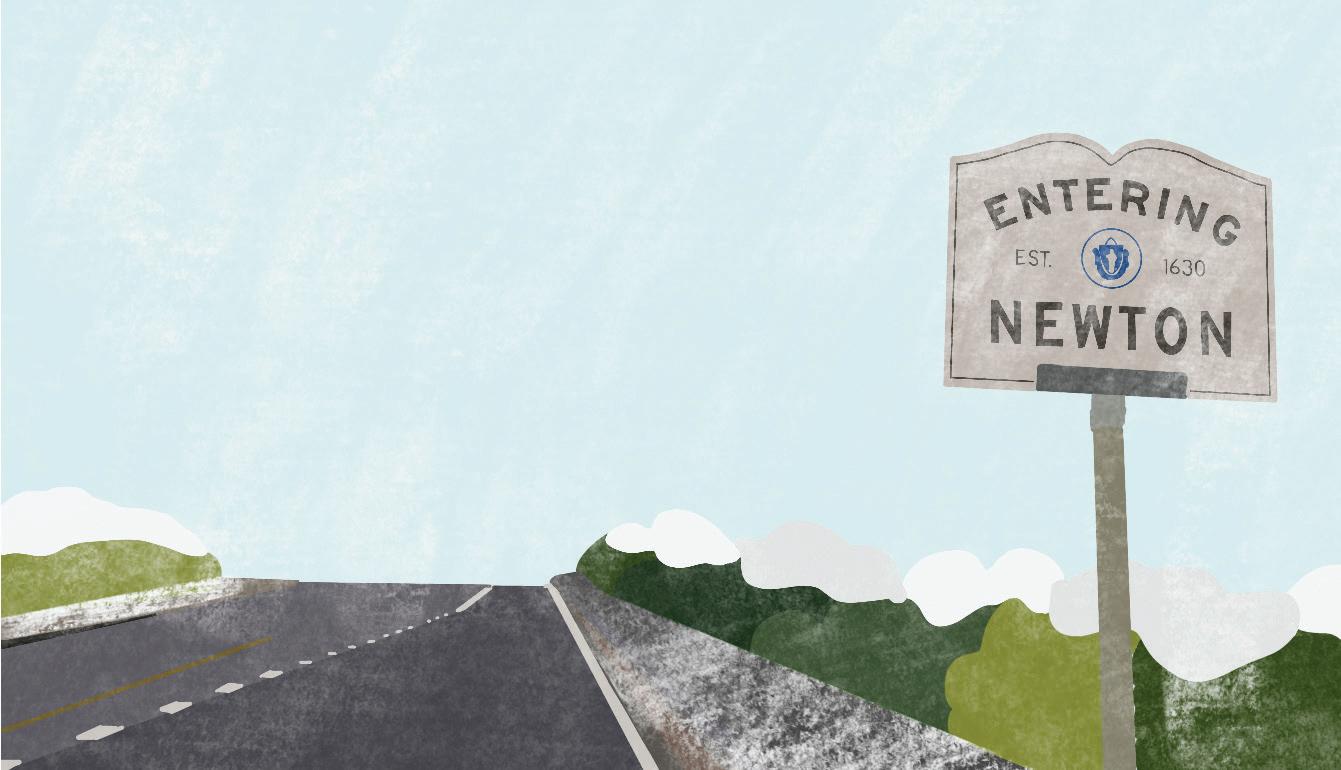
Commonly referred to as “The Heights,” Boston College’s campus is known for its hilly topography. For some students with disabilities, BC’s many staircases and inclines impair their ability to get around campus.
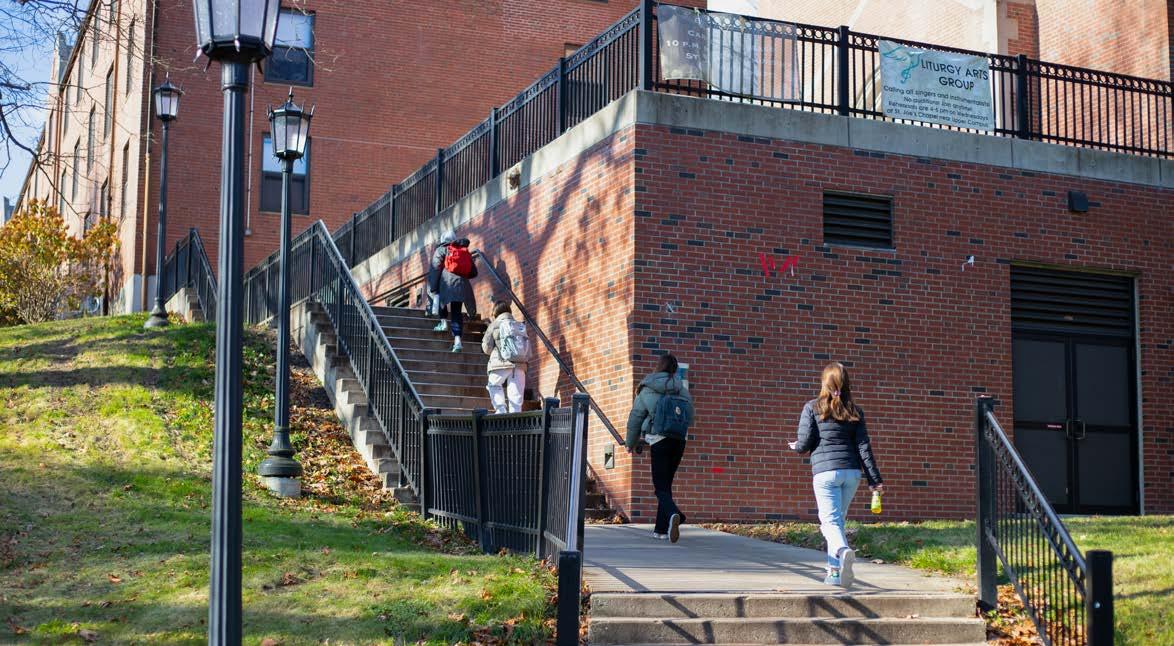
In January 2014, the state of Massachusetts received a pair of complaints about the lack of campus accessibility at BC. In response, the Massachusetts Department of Safety Architectural Access Board (AAB) investigated BC’s campus for its compliance with the Code of Massachusetts Regulations Title 521, a collection of AAB codes. This investigation followed another inspection in 2015 after students and alumni filed a complaint with the U.S. Department of Education’s Office for Civil Rights in 2013.
Since the investigations, the University has made several strides
an effort to meet state standards, students continue to push for increased accessibility on campus, along with increased inclusivity of students with disabilities.
Most recently, UGBC’s Council for Students with Disabilities (CSD) is collaborating with BC Athletics to include closed captions
just heard of horror stories that people were dropping out because they weren’t getting the services that they needed to be successful in school and to be able to live on campus to be able to get to class,” Mallozzi said. “It was very disheartening because I had such a positive experience at BC, even though it was so long before that, and to hear it getting worse instead of better was very disheartening for me.”
After the AAB—which “enforces regulations designed to make public buildings accessible to, functional for, and safe for use by persons with disabilities”—investigated the 2014 complaint, it found over 55 violations in or around 22 different locations on campus, such as Stokes S-195, Gasson Hall, and Cushing Hall.
The violations ranged from a lack of a listening system in a lecture hall to ramps with elevation rates above the maximum slope to inaccessible building entrances, according to documents obtained by The Heights
Under Massachusetts state law, the AAB is authorized to act against violators of its regulations, including, but not limited to, taking legal action to prevent the further use of an offending facility. The AAB also has the authority to impose fines of up to $1000 per day per violation for willful noncompliance with its regulations.
When she returned to campus in more recent years, Mallozzi noted some of the updates made since her 2014 visit.
“I have been on campus recently, and I saw, finally, an access point to the front door of O’Neill Library, which is really great,” she said.
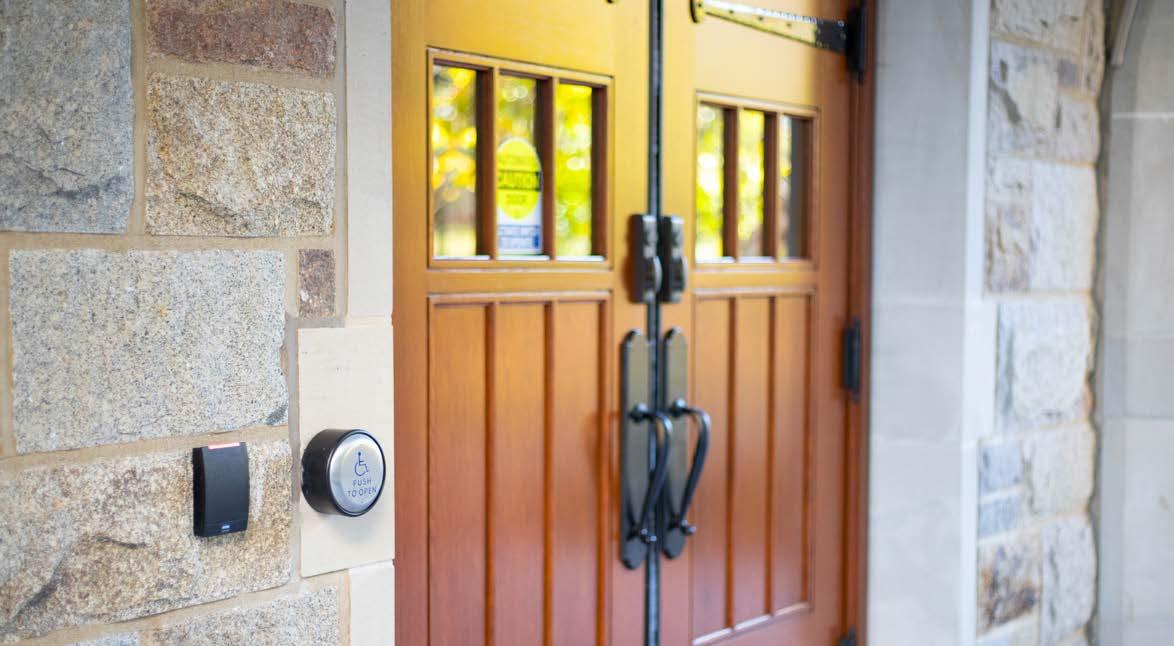
itor students’ concerns, Kelly said.
“The DSO website also includes a campus accessibility reporting form that allows any student to report a problem they have with physical accessibility on campus,” Kelly said. “The office and divisional leadership also routinely meet with the students from [CSD] to discuss student accessibility concerns.”
In 2015, UGBC created CSD to build a coalition for students with disabilities on campus.
Nick Claudio, BC ’22 and GMCAS ’23, said one major issue CSD has worked to address in the past is the lack of an accessible pathway to
submitted a referendum for an Upper Campus pavilion under his name, as CSD could not submit the referendum in any official capacity, due to conflicts of interest.
“I just submitted everything in my name, and then obviously everyone at the council backed it and helped share it with everybody else on campus because it needed to get a certain number of signatures in order to go on the ballot as a referendum,” Claudio said. “So we got that passed … then also that year, we got a resolution, and the Student Assembly (SA) passed in support of it.”
to improve campus accessibility. General Counsel at BC Nora Field said advancements include building renovations, improved maintenance, and continued monitoring of campus and students’ needs in an email to The Heights

“The improvements are too numerous for me to list, but include new ramps at Vanderslice, a new walkway and ramp between Maloney Hall and O’Neill library, a new ramp at Trinity Chapel, and improved signage throughout campus,” Field said. “In addition, all new buildings, including, most recently, 245 Beacon, are compliant with accessibility standards.”
While the University has made
for gameday videos and broadcasting on the jumbotron in addition to working with the University to create a more accessible pathway to Upper Campus, according to Jonah Kotzen, MCAS ’24 and the CSD policy coordinator.
As a student in the late ’90s, Adriana Mallozzi, BC ’00, said she had a generally positive experience as a student in a wheelchair, relying on back doors and roundabout ways to get to her classes.
But in 2014, when Mallozzi revisited BC, she said the campus was much less accessible than she had remembered it to be due to several construction projects.
“When I did come in 2014, I
Capital Projects Senior Designer Mark Lewis said in an email to The Heights that Facilities Management has a quality relationship with the AAB, as the two organizations often work together. Lewis also said his office’s consulting architects take accessibility on campus seriously and follow the law to its full extent.
“Over the years, any new buildings constructed on campus are required to be fully accessible,” Lewis said. “We have used these opportunities to be able to connect parts of campus that have previously been difficult to access. The newly completed 245 Beacon Street Science Building and new Residence hall at 2150 Comm Ave … are both very good examples of this.”
On behalf of the Office of the Dean of Students, Associate Vice President and Dean of Students Corey Kelly said BC has made numerous physical accessibility improvements to Newton Campus and Brighton Campus in addition to buildings on Main Campus.
According to Kelly, the Disability Services Office (DSO) reaches out to all first-year students registered with their office to discuss their individual needs. The office also has several measures in place to mon-
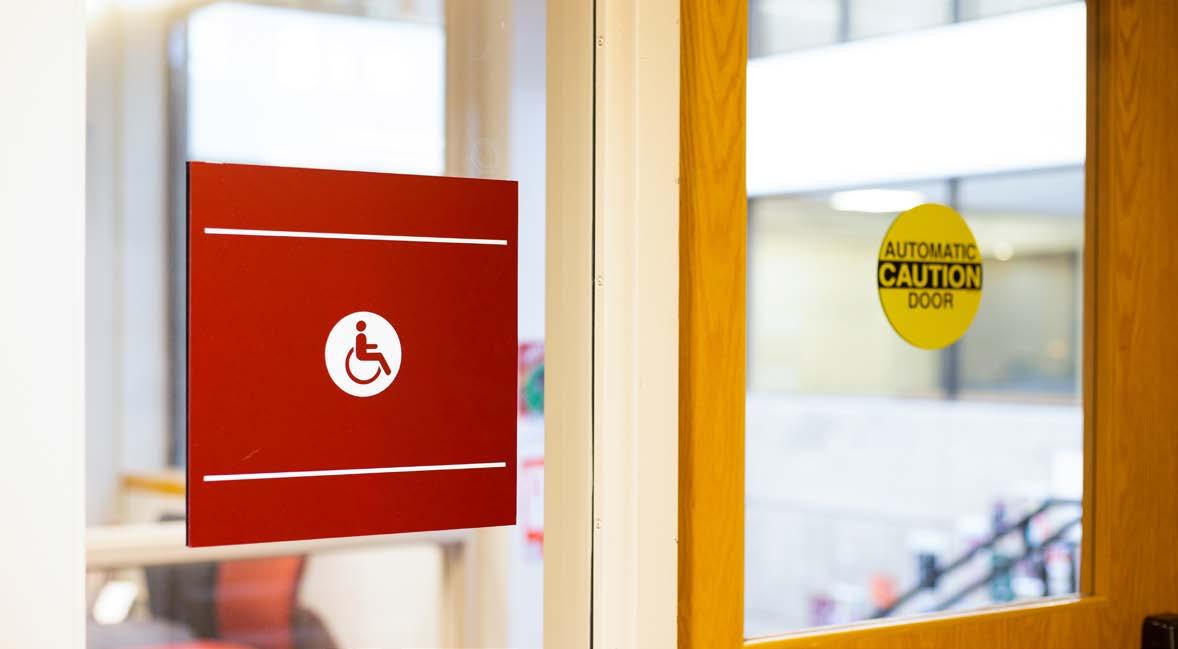
Upper
In order for the referendum to appear on the 2020 UGBC ballot, students had to first approve it. In the subsequent election, 93 percent of BC students approved the referendum in favor of the pathway, according to a 2020 Heights article.
The SA then passed a resolution in November 2020 calling for a more accessible route to Upper Campus.
Sarah Farnan, chair of CSD and MCAS ’23, said she became involved with CSD in 2020 after realizing how inaccessible some parts of campus were when she tore her ACL.
Since she joined as a sophomore, she said the council’s main achievement was getting the University to include a more accessible pathway to Upper Campus in its building plans.
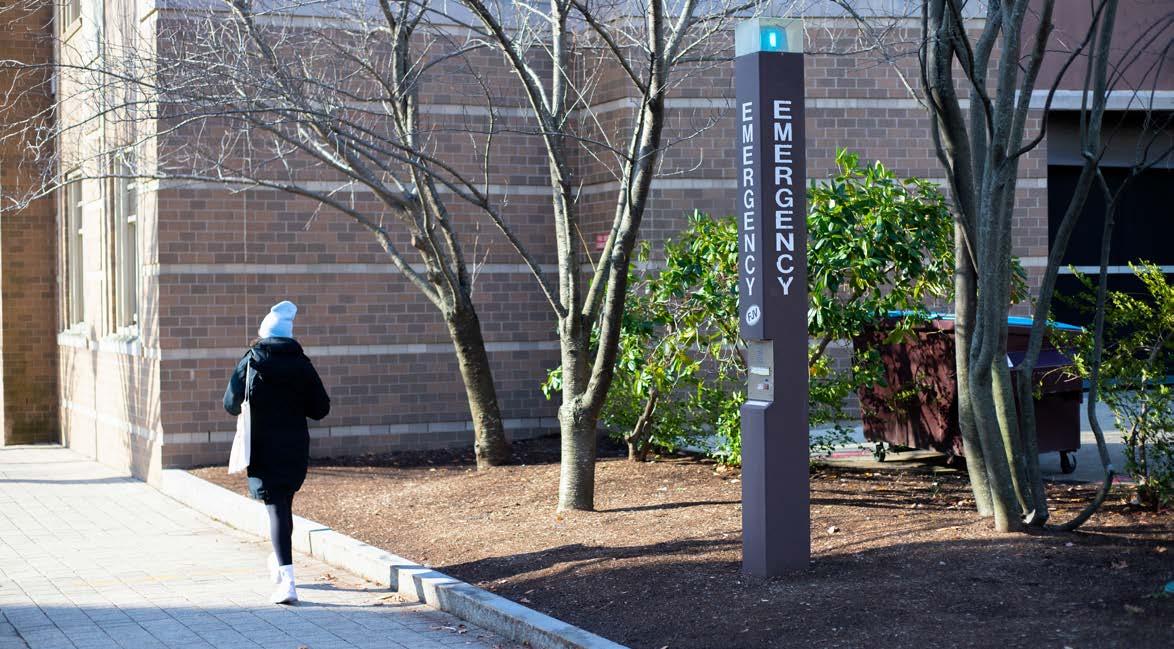
“It was very difficult to get the administration to commit to it,” Claudio said. “We had a few people, you know, on the lower end of the administration really trying to help us out a lot. The problem was getting the higher ups to commit to it.”
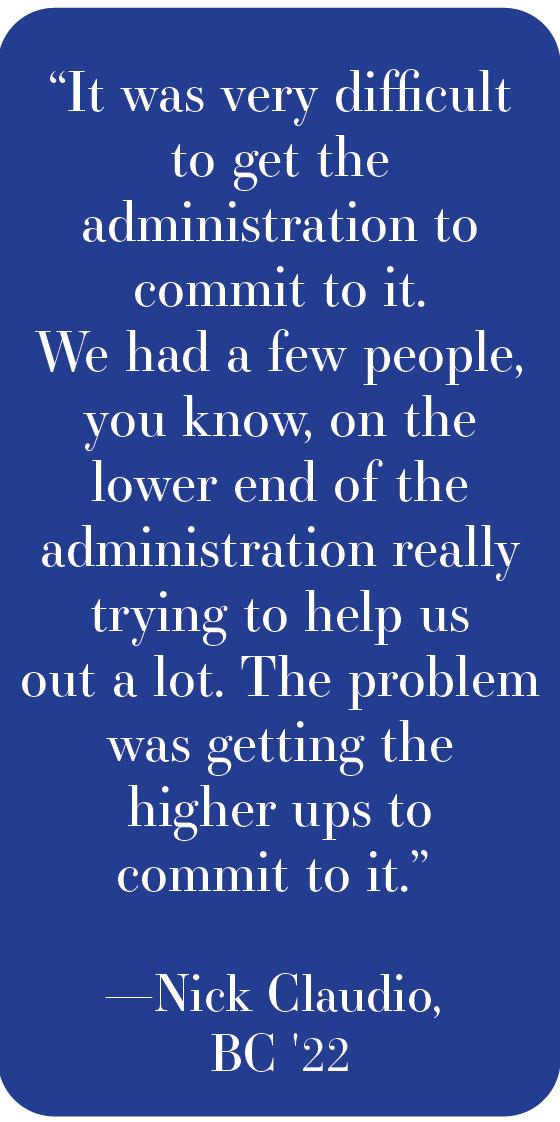
During the 2020–2021 school year, Claudio, then-chair of CSD,
“My freshman year … [the University] made it known pretty quickly that students with wheelchairs or with any sort of physical disability along those lines had to live on Newton because the only way to access Upper is through walking up stairs,” Farnan said.
Campus. Alongside Conor McCormick, BC ’22, Claudio said CSD worked with the administration to bring back the initiative.Accessibility, from A5
According to Kotzen, CSD is working with the University to advance this initiative.
“There is a project being worked on that will make Upper Campus accessible,” Kotzen said. “That’s directly from [the] administration.”
Facilities Management released an update in February that included a plan to build a pavilion at the corner of Gonzaga Hall and Kostka Hall, which would hold an elevator for students with disabilities to use to easily access Upper Campus.
In addition to improvements to Upper Campus, Kotzen said another project he is working on is ensuring that blue lights—which are rectangular boxes emitting a light that call BCPD when pressed—on campus are more accessible to all students. Students in wheelchairs, Kotzen said, cannot reach blue lights that are three to four feet from a curb or planted in mulch.
Kotzen said he is working with
BCPD Lieutenant Jeffrey Postell to combat this issue.
“If you really think about it, the whole purpose of that is that blue lights are there to help, you know, the most vulnerable on our campus feel safer,” Kotzen said. “And if students with physical disabilities aren’t feeling safe and they don’t have access to a blue light that’s next to them, like how can we ensure that they really are safe on our campus?”
Other current CSD projects include temporary ramps in the Mods along with their ongoing efforts to include closed captions on the jumbotron at gamedays.
To institute the closed captioning, Kotzen said he is coordinating with Jamie DiLoreto, associate athletics director for marketing and fan engagement.
“[I’m] working with Jamie DiLoreto who is, you know, in athletics … to ensure that all future game days have captions on them, have subtitles, whether that be the pre-recorded videos from athletes
talking about a certain, you know, athletic topic, or live broadcasting captioning,” Kotzen said.
In addition to these concrete advancements, Kotzen said CSD’s
mester, actually two Herrd posts, that directly targeted individuals with disabilities, making a joke about them,” Kotzen said. “I want to change the culture surrounding students with disabilities on our campus and really make it more inclusive. So, I would say, you know, our goal is to end the social isolation of students on campus with disabilities and to make it feel like they’re actually at home.”
Moving forward, Kotzen said he hopes to see all students openly welcome individuals with any disability.
University, Farnan said CSD works as a liaison between the student body and the administration to influence future construction plans.
“If we see an issue, you know, maybe a certain current student within our club notices a shortcoming within the administration, then we can point that out to them and find effective solutions, and they’ve been really helpful thus far,” Farnan said.
When CSD discusses a disability problem with the University, Kotzen said the BC administration is usually receptive.
current goal is to combat the stigma against and social isolation of students with disabilities.

“As you probably heard, there was a Herrd post earlier on this se-
“I think it’s a really tough time to be an individual with a disability, and it’s a very tough place to be an individual with a disability. … I think in all aspects, it’s difficult, and I think that ourselves as able-bodied people need to be willing to have those conversations with individuals … with disabilities,” he said. “We need to be allies.”
By communicating the needs of students with disabilities to the
“I think the CSD-University relationship is good,” he said. “They’re more than happy to listen to any initiatives we have representing students with physical disabilities, any disability in general to be honest as well. … I think that by working with the administration, we could accomplish something huge, whether that be ensuring 100 percent accessibility on campus for everyone.” n
Lakhani, from A1
According to Care for Chemo board member and family member Honeyfa Rehman, Lakhani personally researched products and called companies to get discounts on products and ask for donations.
“[Lakhani] would … stay on [the] phone for hours hoping to speak to a person in authority,” Rehman said.
When the organization first began, Lakhani said she was the only team member—with the occasional help from family members—and she personally went to deliver boxes to chemo centers in hospitals around the Dallas area. Now, with the help of monetary donations and volunteers who package and deliver boxes, Care for Chemo has been able to expand its services to hospitals in the New York area, she said.
This fall, Lakhani returned to Boston College and worked to get boxes delivered to local hospitals, including Newton-Wellesley Hospital and Mass General Cancer Center, she said. Currently, Lakhani said Care for Chemo is also pending approval for official 501(c)(3) status.
In addition to packaging and delivering boxes, Lakhani said volunteers can help at fundraising events or donate to buy supplies for boxes.
If someone wants to sponsor a box to go to a specific patient, they can fill out a form on the organiza-
tion’s website and donate the necessary amount to cover the cost, she said.
Though she enjoys seeing how her efforts have impacted others going through chemotherapy, Lakhani said she likes to stay behind the scenes in an effort to be mindful of how patients may feel.
“It’s been amazing,” Lakhani said. “I try not to meet them too much, though, because I don’t want people feeling as if they are a charity case or something like that.”
While Lakhani came up with the initial idea for Care for Chemo, she said she has not been without help.
Her parents have been a great source of advice and support since she had no previous experience with nonprofits, she said. She also credits her tech-savvy 18-year-old brother for helping her with graphic design, such as creating the nonprofit’s logo and managing the website.
Care for Chemo has a two-person board of directors, an intern, and volunteers who help package and distribute boxes. One of her board members is Rehman, who has previous nonprofit experience. Rehman said she was closely involved from day one—even before Lakhani had decided what she would name the company.
In all aspects of Care for Chemo, Rehman said Lakhani is friendly, outgoing, and detail oriented and
has served as an inspiration for her.
“One thing she would always say [is] ‘Don’t worry. I can do it. I got this,’” Rehman said. “I would have tears in my eyes. Half my age and look how strong she is.”
Lakhani describes herself as a goal- and achievement-oriented person, but since her cancer diagnosis and the adjustment of returning to BC this fall, she has changed her mindset about both the day to day and the future.
Although she was excited to return to BC after being at home for 10 months, Lakhani also said she faced a fair number of challenges.
“I guess I didn’t recognize how many memories I had with Boston College and campus and the small things that like, for example going to the Rat would freak me out,” Lakhani said. “I had to like take a step back and really [think], ‘Okay, am I taking care of myself?’”

Lakhani also described the challenge of managing her time as a busy college student balancing classes, friends, extracurriculars, and running a non-profit.

“Something that I’ve … come to realize in like the first couple of weeks [since] I came back after the summer, I was doing too much at once,” Lakhani said. “It’s like building in time for myself every week, whether that’s like a Res walk or whether that’s like literally forcing
myself and being like, ‘Okay, I know you have free time, and I know you want to see all these friends … but no, you’ll have to sit on your own journaling.’”
like that?’” Lakhani said. “And I was like, ‘Okay, this happened, and this sucks. And this is literally the worst. But how can I help others now that I know about it?’”
Lakhani is double majoring in applied psychology and transformative education. Since starting her time at BC, she said she wanted to work in some type of educational administration. Her work with Care for Chemo has inspired her to look for more managerial experiences, she said, so this year she added a minor in management and leadership.
Creating Care for Chemo also helped her change her mindset and allowed her to get a bigger picture view of herself, rather than just focusing on her diagnosis.
“When I was diagnosed I lost a lot of trust for both myself and my body because I was just like, ‘Whoa, like how did my body turn on me
For anyone enduring a difficult situation, whether it relates to health, family, or academics, Lakhani suggests taking everything one day at a time.
For those looking to also start their own nonprofits, Lakhani said she welcomes anyone who wants to reach out to her. She encourages them to do their research and know what they are getting into, but also to just go for it.
“I think the world could always use more nonprofits,” she said. “The world could always use people giving back. The world could always use love because there is so much ugliness and bad in the world already that people will benefit from you.” n
 By Stephen Bradley Magazine Editor MC Claverie Assoc. Magazine Editor erin Flaherty Asst. Magazine Editor
By Stephen Bradley Magazine Editor MC Claverie Assoc. Magazine Editor erin Flaherty Asst. Magazine Editor
Throughout 2022, several Boston College students, alumni, and other community members showed dedication to BC through their unwavering drive to innovate and inspire.
From a Chorale director to an entrepreneur to a pizza shop owner, these individuals worked to improve
campus life by finding solutions to issues impacting the BC community and beyond.
The Heights is proud to award the following individuals the 2022 Momentum Awards.
As the winningest coach in NCAA hockey history, Jerry York made a strong impact at BC from the time he arrived as a player in 1963 to his retirement this past April after 28 years.
While his resume boasts nearly every accolade and accomplishment
a hockey coach could gather, the memories and stories of his players and colleagues prove that York’s legacy at BC is not just about a filled trophy case.
Rather, it is about impact off the ice.
Finney, who has been the director of the University Chorale of Boston College since 1993 and the BC Symphony Orchestra since 1999, was honored by the Choral Arts New England Board with its Alfred Nash Patterson Lifetime
Achievement Award in 2020. He was namd after Patterson, a conductor
music in Boston in the 1950s.
Read the rest of this story at www.bcheights.com
First to compete was Team Presenting Africa to U (PATU), composed of PATU co-captain Eunice Azamati, CSOM ’25, and Sena Deressa, MCAS ’24.
The duo started off strong with powerful moves that excited the audience, but as the stage lights turned to red and “Lambuxa na Bo” by Loony Johnson played, they transitioned into coladeira, a
sensual Cape Verdean partner dance. The pair’s intense chemistry filled the room, accompanied by cheers and shouts from the crowd.
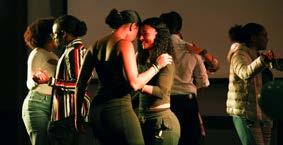
McBarnett, affectionately known as “Ms. Smiley,” said that the pair “came correct” and emphasized their captivating facial expressions in her critique after the performance.
Next up was Team Females Incorporating Sisterhood Through Step
(F.I.S.T.S.), consisting of F.I.S.T.S. captain Srina Lacet, MCAS ’24, and Elaine Keleta, MCAS ’24. The duo incorporated a skit into its performance that showed an upperclassman (Srina) teaching a freshman (Elaine) how to get into a party. The dancers’ ticket inside was step dancing, which they performed for the audience with stomping feet and clapping hands.
A performance by Team Masti followed, featuring dancer Angana Saha, MCAS ’24, paired with Miladi Teo Najera, LSEHD ’23. The duo performed a unique mix of funaná and Bollywood fusion, featuring jingling golden waist chains that emphasized their intense hip movements.
Team Sexual Chocolate (SC) took the stage next. Levi Ngabirano, CSOM ’25, from Sexual Chocolate partnered with Camille Paula, LSEHD ’23, to deliver a sensual performance that drove the crowd wild.
The passionate song “Beijam” by Djodje played as the pair danced slowly together before transitioning into SC’s
classic step dancing style.
The duo finished off its set by reverting back to the original slow and intimate dancing. The two shocked the crowd with a dip and kiss, followed by Paula running and jumping into the arms of Ngabirano, who pinned her to the ground for a dramatic finish.
“I feel like we all need to go to mass right now,” Bell joked after the intense
performance.
Team Vida de Intensa Pasión (VIP) delivered an equally passionate performance for the final act. Aiche Ba, MCAS ’23, captivated the audience in a dress adorned with rhinestones and tassels. She showcased her acrobatic skills in the team’s big finish as her partner, LA Almanzar, CSON ’23, aided her in a backflip and lifted her onto his shoulders.
On a cold Friday night, the Common Tones brought students outside of their cozy dorms for a sweet treat. In Devlin Hall 008, the a cappella group presented CommonToast: A Brunch Café!, a thematic show that warmed the night for many students.
Audience members waited patiently
for the singers to come in as the projector displayed an introductory video of the group’s members.
Sticking to the brunch theme, members of Common Tones dressed as different breakfast foods and drinks, including french toast, a banana, a fried egg, and a mimosa.
Picnic blankets, colorful balloons, and inflatables decorated the stairways, tables, and podium in the room, adding
to the upbeat atmosphere. Desk lamps stood throughout the first row, making a make-shift spotlight on the center of the room where the members sang.
The a cappella group burst in through the main entrance of the auditorium, inciting loud cheers and applause from the crowd. The group debuted its a cappella version of “Fruit Salad” by The Wiggles. The song was a playful, theme-fitting way to begin the night.
Next, “Drops of Jupiter” by Train, a signature Common Tones song, transitioned the audience from a playful mood to a sentimental one. “Titanium” by Rihanna, another Common Tones classic, came next, followed by “Yesterday” by The Beatles.
After these tender performances, Ana La Russa, MCAS ’25, lightened the mood, debuting a hip-hop version of “Killing Me Softly with His Song” by Fugees. La Russa’s melodic voice shined throughout her second solo performance, fueled by the audience’s applause.
During a brief intermission, the
group’s music director, John Ross, LSEHD ’23, thanked everyone for making the show possible, and the audience recognized the Common Tones’ efforts by applauding and cheering. The animated audience then tuned in for the next song, “Juice” by Lizzo, with the same amount of energy.
“Feeling Good” by Nina Simone and “Favorite Crime” by Olivia Rodrigo were next. Then, the elder members of Common Tones left the stage to give the spotlight to the group’s new members.
The audience joined with claps to support the new members’ first performance of “Party in the U.S.A.” by Miley Cyrus.
“December, 1963 (Oh, What a Night)” by Frankie Valli and “Falling Slowly” by Glen Hansard and Markéta Irglová were two of the last performances of the night.
The Common Tones concluded their show with president Becca Speer, MCAS ’23, singing “Valerie” by Amy Winehouse, shining with her enigmatic stage presence. As she hit the final notes, she earned a standing ovation from the audience.
This time around, it wasn’t Boston Red Sox fans packing Lansdowne Street, but instead, the crowd was for a 23-year-old Texan with a cool voice and a commitment to getting his fans to dance.
Sloan Struble, better known as Dayglow, played a sold-out show at Boston’s House of Blues on Friday, Nov. 18.

It seemed that Dayglow was less concerned about putting on an elaborate show and more about having a good time and connecting with the audience. The concert felt like a dance party with your friends, encouraging audience members to forget about everything and just immerse themselves in the moment.
Struble mentioned that he hoped his
concert would make his audience feel like Dayglow was a wedding band, playing for the crowd to enjoy themselves. This was certainly the atmosphere at House of Blues.
The concert began with the stage in total darkness. As white lights suddenly flashed across the stage, Dayglow came onstage playing “Radio” from his 2022 album People In Motion. Struble’s voice
is smooth with a strong falsetto, and he sounded on stage just like he does on his records.
Struble smiled widely and moved with the music, appearing to genuinely enjoy himself onstage.

“I try to remind myself that everyone here wants to have fun,” Struble said in an interview with The Heights
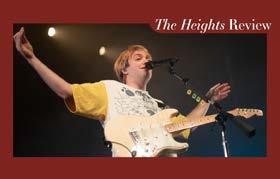
His desire to make the concert a fun experience for the audience was apparent throughout the night. Before his third song, “Hot Rod,” Struble exclaimed, “Thanks for showing up. We’re just having fun, baby. Let’s dance!”
Struble consistently engaged with the audience, including having the crowd yell out “Happy Birthday!” to a young woman in the crowd wearing birthday apparel.
“I want it to be a very performative and musical experience,” Struble told
The Heights. “I try to put the emphasis on the crowd more than myself.”
Struble said that one of his favorite bands and biggest inspirations is the French pop-rock band Phoenix. He explained that while the band performs with great energy and is a lot of fun, Phoenix also gets straight to the point of the concert: music.
Struble spun around the stage, dancing with all the different band members. He even ran laps during “Close to You.”
Struble played synthesizer for a number of the songs. He also used a kazoo-like instrument and a voice-changing microphone for “Second Nature” and a cover of “FunkyTown” that smoothly transitioned into “Medicine.”
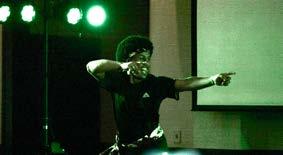
One woman’s love for womanhood lies in understanding men solely as lonely and twisted. Daphne (Meghann Fahy) admits this while she and her husband Cameron (Theo James) present themselves as a seemingly perfect, attractive, and wealthy couple. They have no care for the cruel realities of the world.
The second season of The White Lotus returned with a new cast, exploring another saga of ironic scandal and ills of modern society. The first episode premiered on HBO Max on Oct. 30, and each following installment comes out once a week until Dec. 11.
Daphne knows that her husband cheats on her and has dealings with corrupt business partners. Her approach is not one of sympathy or self-
pity, however. Instead, she does what she wants when she wants, including renting a gorgeous Italian villa for the night.
“I feel sorry for men, you know,” Daphne says in a monologue. “It’s
like they think they’re out there doing something really important, but really they’re just wandering alone.”
Director Mike White followed the same format as his successful first season, where events happen over the course of a week, and each episode represents one day at the White Lotus resort.
TVThis new season features new wealthy families, as well as Jennifer Coolidge in her continued role as Tanya McQuoid. This time The White Lotus resort is in Sicily, with another set of fastidious staff members and lots of posh resort eye candy for viewers.

The focus of the first three episodes continues themes of luxury and vapidness in a satire of the rich and

A father and his daughter spend a holiday together in Turkey. The trip is short-lived, but through the eyes of both characters, its effects last a lifetime. Sophie (Frankie Corio) is a pensive and witty child on the way to becoming a teenager. Calum (Paul Mescal) is a young man trying his best to play the role of a father.
Aftersun, Charlotte Wells’ directorial debut, shows the faint tragedy of all parent-and-child relationships: Despite both parties’ best intentions, they will never get to fully understand one another.
This theme becomes more evident with time, as it becomes impossible to ignore that parents carry an identity outside of parenthood and children are forced into independence.
Distanced by age, individual experiences, and many unsaid things, Sophie and Calum portray the complex reality of family relationships.
The movie, released on Oct. 21, is a glimpse at Sophie’s recollection of the time she spent together with her father as an 11-year-old. Given that the story
is a retrospective product of Sophie as an adult, the movie is nostalgic at its core. But what it is nostalgic about remains unanswered by the end of the movie.
Aftersun leaves many things open to interpretation not in an artistic way, but in a failed appearance of senseless ambiguity. Memories can often be abstract, inconclusive, and full of gaps. In this way, Wells is able to portray the process of remembering accurately.
Yet Wells fails to provide anything concrete to her audience. The movie attempts to be cryptic through exces-
sive subtlety and silence.
Even though the two characters are always engaged in vacation activities like sunbathing, swimming, playing pool, or dining with live music, viewers feel the constant sensation that nothing is happening.
The film presents itself as an anti-plot that guards every prolonged scene. The viewer is forced to anticipate a sort of catharsis, a sudden revelation, or a dramatic turn of events. This moment, however, never comes.
Akin to Sofia Coppola’s 2010 film Somewhere, Aftersun is a delicate movie that relies on little details to express bigger emotions. Yet, Aftersun reveals too little of its characters, specifically of Calum, making it hard for viewers to connect to him.
Calum attempts to find inner solitude and make peace with himself, rigidly throwing himself into tai chi and meditation. There is something wrong with Calum—he suffers in private, as proven through an unsettling scene in which he sobs while Sophie is away.
By MC Claverie Assoc. Magazine EditorOver the past four months, I’ve discovered that news editor Erin Shannon and I are kindred spirits.
I remember the first time I talked to Erin on a chilly February night during our freshman year. Though we didn’t really know each other at the time, as we walked down the Mac hallway casually chatting, I knew she was someone I wanted to be friends with.
Honestly, I was intimidated by her. She seemed so calm and collected, which is something that freshman-year me was most definitely not.
As Erin and I got to know each other better sophomore year, I realized that she wasn’t really that calm and collected either. She is probably the most chaotic person I know. From chugging peach Snapple teas to our Wednesday cocktail nights to her inability to sleep more than five hours a night, Erin’s electric energy is something I have come to love. Now, I rely on her as one of my best friends, my fellow editor, and my roommate.
After begging Erin to let me write her iEdit and harassing her to finish her playlist, I was ecstatic to find that not only did she include several of my favorite songs, but we also have extremely similar music tastes.
With its alternative rock vibe and subtly sad lyrics, Briston Maroney’s “Freakin’ Out on the Interstate” is the perfect opener to Erin’s playlist. The raspy lead vocals with a rock twang made it an immediate add to my own Fall 2022 playlist.
As I listened to this song next to Erin on the blue couch in our living room, I couldn’t help but get emotional. In January, I’ll be across the Atlantic from Erin while I study abroad in the Netherlands. Now, more than ever, I’m terrified to go, but Maroney’s lyrics provide a touching reminder.
“Fear is just a part of love, and one thing I’ve found is love’s what you deserve,” Maroney sings.
Erin and my friendship is these lyrics brought to life. We often talk about what it will be like being so far away from each other. Yet, I know in my heart that this fear just proves how strong our friendship is.
Erin’s playlist stays surprisingly on theme with a series of alternative rock and indie songs. “Trouble” by Cage The Elephant and “No Rain” by Blind Melon are reminiscent of my middle and high school years and are wonderful additions to an already banging playlist.

Diverting from her indie rock theme, “Rose Tattoo” by Dropkick Murphys and “Plastic Hearts” by Miley Cyrus show Erin’s chaotic personality. As someone who identifies as “culturally Irish Catholic” and allegedly had her first sip of Guinness at age 10, I am not surprised Erin snuck an Irish drinking song in her playlist.
Erin wraps up her playlist with “A Good Song Never Dies” by Saint Motel, and I don’t think she could have chosen a more fitting last song.
Read the rest of this story at www.bcheights.com
Black Panther: Wakanda Forever introduces Marvel fans to a new, in-depth storyline of heartbreak, loss, and grief. It’s a superhero movie that faces more than metaphysical villains and apocalyptic events. It’s also a raw and emotional dissection of the movie’s hero, Black Panther After the record-breaking release of the first Black Panther movie in 2018— starring Chadwick Boseman, who died after a fight with colon cancer in 2020— Marvel fans built high expectations for the long-awaited sequel, Black Panther: Wakanda Forever
The movie ventures through similar themes as its first iteration, including the fear of colonialism and conflict in political power while, of course, including thrilling fight scenes that are staples of Marvel movies.
But the film’s director, Ryan Coogler, introduces the hidden world of Talokan—an underwater country of blue beings—and the half-human villain, Namor (Tenoch Huerta) to pit another outcast country and character against Wakanda and the Black Panther.
As the Marvel cast and crew faced the tragedy of Boseman’s death in 2020 after an acclaimed acting career, there was a question of whether Marvel would recast Boseman’s character or allow a new character to put on the Black Panther suit.
The company chose not to recast the role, which left fans wondering who would take on the hero’s responsibilities.
The new Black Panther suit that appears in Wakanda Forever is sculpted for the new hero and adorned with shiny gold lines, offering a touching tribute to Boseman’s character T’Challa and spotlighting the impressive costume design on the high-budget film.
Shuri (Letitia Wright) deservingly takes the lead role as the tech genius and the empowering princess of Wakanda. Rather than replacing T’Challa’s original role, Shuri joins the rising power of female characters in the Marvel universe. Similarly to the story of Scarlet Witch in WandaVision, she becomes a resilient and pertinacious character as a consequence of the many deaths she faces.

Coogler commemorates T’Challa’s legacy and Boseman’s career by allowing the characters and audience to confront death head on.
He elaborates on how Shuri deals with familial deaths, bringing expressions of grief and agony to a Marvel movie. Wright’s powerful acting grasps the pain in dealing with death as she breaks down in tears fueled by rage.
Beyond coverage of loss in Black Panther: Wakanda Forever, the exciting car chase scene that takes place in Boston and
battles on boats were expectedly immaculate. Even some touches of comedy were not over the top and were complementary to the movie’s content.
Black Panther: Wakanda Forever contains classic superhero elements in its
high-tech action scenes and introduction to volatile villains and funny sidekicks. But Coogler takes a step beyond the Marvel stereotype by unpacking the taboo of mourning and grief, and he does so righteously.

the energy to hold the more painful truth: I had done everything possible with the time I was allotted. It just so happens that I didn’t have a lot of time. Why? Because I was busy being nothing more than a hamster in distress.
I have never owned a pet hamster, but I can imagine they are fun, lovable creatures.
I once had a classmate in elementary school who would not stop raving about her orange hamster, Priscilla. She looked for every opportunity to talk about her, sharing moments when the hamster had curled up in her hands during family movie nights, performed a tummy roll for a couple treats, and kissed her nose softly.
“Priscilla is such an impressive hamster,” my classmate told me. “She honestly feels like a human best friend.”
Now, although hamsters may make convincing humans, it goes rather uncontested that humans do not make good hamsters, which is something I wish I realized earlier in the semester.
You see, I am in the middle of one of the worst midterm seasons of my life. Having taken what felt like a billion exams last week, I entered this week hoping to get a reprieve. Wishful thinking. Instead, I stared down at what looked like the Test Taker’s Hall of Shame, with upcoming exam after upcoming exam simply waiting for me to prove that my head was, in fact, rather empty. Unfortunately, this visual was not simply the dramatized product of my exam anxiety, but a prophecy that was tragically fulfilled.
I can still smell the ash lingering in the air from the exam I bombed yesterday. I can still feel the resulting devastation in the pit of my stomach along with a sort of wilting defeat. I continue to carry the burden of responsibility for this tragedy, along with the ominous musings of “what if I had done more?” Burdened by the weight of my failure, I cannot muster
If I were to look back on the past two weeks, I can confidently say that I did not take more than a few minutes of free time to myself. Every moment of every day was consumed with either studying for a midterm, submitting an assignment, or attending class itself. And if I wasn’t doing those things, I was tending to my extracurricular responsibilities, running errands, or tending to my basic needs. In other words, I was a hamster spinning in an endless wheel. Barely managing to tackle each assignment and commitment in time, I was only able to turn my attention to this beast of an exam a few hours before I would meet my fate. Naturally, the odds of memorizing an entire month’s worth of class content in less than 120 minutes are rather dismal, and so you can guess what happened.
Now anyone reading this can understand this is no new story. This is simply college hustle in action. After all, students bust their brain cells on a daily basis. We relentlessly pursue every due date like it is the winning lottery ticket, hoping that the next one will be the last. Although I can engage in this cycle and convince myself that I am becoming an academic weapon, I cannot shake the knowledge that I am little more than a sad, frantic little hamster. College has regimented me such that my every action is taken to progress one peg further in this hamster’s wheel. In truth, I have become robotic in the severity of my schedule. Yet it is not just me. I have watched my friends beat themselves up for not working hard enough, despite sacrificing all of their sleep to study for the next exam. I have watched classmates skip meals to finish assignments on time or isolate themselves to heighten their productivity. Sacrifices made over and over again, all to ensure that they can keep up with the dizzying speed that college demands of us.
I say this with all proper condemnation and sadness, but in all honesty, I do not have a solution to the hamster wheel. It isn’t really up to me. I am no fairy who can wave a magic wand to force the world to stop moving at the speed of sound. I cannot create a magical schedule in which no exams or assignments overlap, or coincide with other commitments. I can’t even transform my own hamster wheel into a nice cozy bean bag (no matter how hard I’ve tried).


Limited as I am, however, I write this article as a way of creating a pocket of space to hold a truth that I often forget: that life is not meant to be a series of deadlines, to-do lists, and external obligations. Devastated as I may be for failing an exam—for missing one rung in this ever-spinning wheel—I cannot forget how full my life truly is. As a human, it is the moments of peace, joy, laughter, connection, and boundlessness that are my birthright. While I cannot access these moments as fully and completely from the ragged insides of my hamster wheel, I can always grant myself permission to step out and experience life more completely. I like to call it opting for the Ferris wheel because in stepping outside of academia’s torture machine, I can gain a higher perspective on my life and the beauty that it holds.
To those of you who have followed me thus far in my musings on hamster wheels and harmful productivity, I sincerely hope that you find time to hop off the wheel today and bask in the stillness that comes with being alive. We are humans, not hamsters, and we owe it to ourselves to carve out the time to simply be.
I suppose, just as my elementary school classmate suggested, hamsters are capable of being much more than fuzzy little creatures. The next time you see a hamster, know that it is a sign that time to vegetate is on the horizon. And if for some reason you don’t see yourself crossing paths with a hamster anytime soon, then let this article serve as the omen you need.
Picture perfect and Hallmark movie–worthy, the first snow of the year at Boston College always warms students’ hearts. On Tuesday, the campus was glistening with snowflakes for the first time, even though it was unexpected after a week of record-high temperatures. It seems like even the BC students from the Northeast and other chilly places can’t get enough of the magic—we’ll never stop running outside with our friends or leaping to our windows to catch a glimpse of our very own snow globe.
self-doubt and accompanying all-nighters spent on your application, leaving you absolutely drained. But despite all this, you somehow made it. You opened the message in the portal, greeted by a rain of digital confetti, realizing it was all worth it.
“Congratulations! You have been accepted to Boston College!”
We’ve all received this statement in one form or another—the one following a cryptic email telling you to check your student portal because an update has been made. An update that holds so much promise and potential, shaping your future from that moment on. It’s often opened during senior year of high school—but it can also be opened your freshman, sophomore, or junior year of college. At a time when life didn’t exactly go as planned. For personal reasons, you found yourself at a college you didn’t like and decided to go through the tedious process of reapplying all over again. This means rewriting your college essay, asking for recommendations, and filling out FAFSA and CSS forms while juggling your current course load. Enough to give anyone a headache. And, yet, you do it anyway.

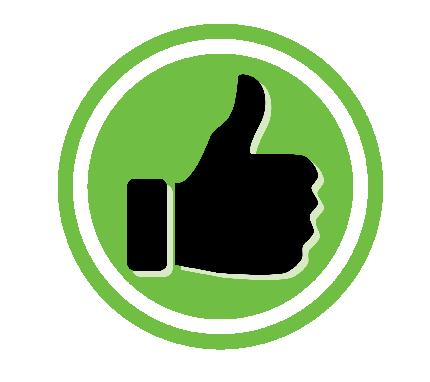
The prospect of having to stay another semester in the middle of nowhere with bad roommates and terrible food or at a college that simply does not feel like home is enough to push you into the nerve-wracking process of transferring. That’s not even mentioning the inevitable
Now, months in, your life feels very different than it was at the start of college. You set yourself on a completely new path, and the person you are now is different from the one you once were. Although you may find yourself with the same hobbies, favorite shows, and study habits, you now have different friends, BC sweatshirts, and a new sense of home. That alone has a substantial impact on your life whether you notice it or not—and I’m here to emphasize the latter.
A problem occurs when you don’t immediately notice the internal change and your brain tricks you into a spiral. It takes a moment of selfdoubt, a bad grade, or one minor inconvenience that makes you feel the immense weight of being a transfer and all that comes with it. Suddenly, your brain rewrites the past, no longer viewing your old college experience as a negative one. Instead, remembering it in a positive light and disregarding all the things that made you leave in the first place. It’s a continuous cycle because it takes one low moment to set off this paradox and blind you toward all the things you’ve actually gained. This is the transfer paradox. One that prompts many questions. Was this the right decision? Would I have been better off staying at my old school? Should I transfer again? When you ask these questions, you fail to recognize how
much your life has changed for the better. These moments of doubt may dictate your life—but it is rather unavoidable.
No matter what, you’re going to run into obstacles. There’s going to be a class that doesn’t transfer over, several core requirements to fulfill, and little to no choice on what your schedule should be. Despite this being a rather bleak outlook, it’s the reality that transfer students go through. As a transfer, you’re greeted by a new set of challenges leading to moments of doubt that make you question everything and deny the facts. The transfer paradox overshadows the fact that you made new friends, went to countless football games, created new memories, and set yourself on an entirely different path for the better. None of those fun memories or opportunities would have happened if you never took the initiative of transferring. Nor would you have found yourself at a college that has a tendency to look picturesque in any weather.

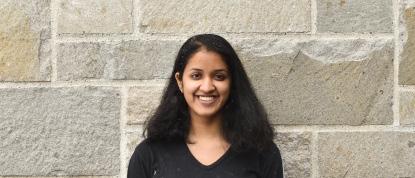

At the end of the day, it’s a matter of recognizing these moments and holding onto them. Realizing that the person you are now is different from the one you once were—the one who would have stayed at a college that wasn’t meant for them. Although transferring is full of its ups and downs, it’s up to you to not fall into that paradox and understand that you made that leap of faith for a reason. One that led you in an entirely different direction for the better.
If you’re familiar with the millennial culture, you know that pumpkin spice is a controversial topic. Just think about PSLs, infinity scarves, Ugg boots, and a holy divergence away from “hot girl summer.” But honestly, pumpkin spice is everything nice. A pumpkin-flavored treat doesn’t have to make every fall lover feel basic. You can really never do too much, and no one should feel ashamed of a good ‘ol pumpkin obsession.
Here’s some food for thought—have you ever noticed how dim the Mod parking lot is at night? It’s niche, but Mod residents and students who call Lower their home sweet home can probably relate to the feeling of walking through the Mod parking lot in the evening and understand the ominous vibes that come along with it. Eags, if you find yourselves getting lost in the darkness, just look toward the Northern Lights (the radiant array of LEDs in Walsh) and you’ll find your way back home.
The date Nov. 15 rings a familiar tune for the battered war heroes who survived the treacherous battle for Taylor Swift’s Eras Tour tickets. Thousands upon thousands of verified fans waited for hours in the queue, only to be either booted out of line or plunged into the race of a lifetime to secure seats. Rumor has it that friendships have been torn, families divided, and angry tweets and emails have been written after Ticketmaster’s deluged website failed too many broken-hearted fans who didn’t get tickets.
Megan Kelly: I’m thankful for my family, friends, eternally patient professors, and my elderly and senile dog (Bubba). I’m thankful for Sundays in McElroy 113, the navy blue copy couch, and the home away from home I’ve built in the last 38 months.
Mac McGee: I’m thankful for campus on a fall morning, the roar of Alumni after an Eagles touchdown, and the smell of coffee being brewed in Hillside. I’m thankful for the peo ple that make The Heights home—and all of the memories we’ve created together.
Lauren Wittenmyer: I’m thankful for my roommates and friends who have made this year the best it can be, my friends and family back home, and for the countless hours spent and memories made in Mac 113.
Emma Healy: I’m thankful for Heights, which gave me some of my best friends, my future career, and a desk in Mac 113. I’m thankful for my family, oat milk, my roommates, and dairy-free Ben & Jerry’s ice cream. And as much as I’m thankful for Ohio, I’m thankful I found Chestnut Hill.
Rachel Phelan: I’m thankful for the support of my family, for my dog, and for my home. Especially now that it is coming to an end, I am endlessly thankful for my time on The Heights friends and experiences it has brought me.
Olivia Charbonneau: I’m thankful for BC for introducing me to my best friend through random selection and I’m eternally grateful for everyone I’ve been with since the 102nd board of The Heights and those who have joined this family since then, changing it for the better.
Julia Remick: I’m thankful for the love and support of my family and friends, morning walks across campus, CoRo coffee, pre-class conversations, comfy chairs in Stokes, and The Heights
Erin Shannon: I’m thankful for peach iced tea, my three dogs, and my wonderful home on Algonquin Rd. I’m also grateful for the undeniably amazing people on The Heights who are responsible for my most memorable moments at BC.
Megan Gentile: I’m thankful for Alumni Stadium on Saturdays, Oxford commas, and the comfort I feel in my corner of Mac 113. Most of all, I’m thankful for my health, loving family, supportive friends and roommates, and the people on The Heights who have made BC feel like home.
Stephen Bradley: I’m thankful for a breakfast consisting of a butterand-jam tartine, orange juice, and a shot of espresso. I’m wholly thankful for The Heights—from the magazine section to Mac 113 to the people who turned BC into a home.
Victor Stefanescu: I’m thankful for the behind-the-scenes people who make BC so much greater. The dining workers who welcome you with the biggest “hello” in the world. The bus drivers who will wait an extra moment when they spot you in the distance. And many more.
Kate Canniff: I’m thankful for my lovely walks to cam pus, iced coffee despite the dropping temps, my friends for our good chats, and the endless support from my family. I’m also thankful for these past two years on Heights where I’ve met and learned from amazing people.
Tommy Roche: I’m thankful for my caring professors and even more caring friends at BC. I’m also thankful for my thought-provoking conversations in and around Mac 113, as well as the Flutie Flakes box that sits on my dorm shelf.
Julia Kiersznowski: I’m thankful for bagel sand wiches and Christmas movies in November. I’m thankful for my past years at this magical place, the people that make senior year such a bittersweet goodbye, and Mac 113—the place I hold most dearly in my heart.
Isabella Pieretti: I’m thankful for my family, freshmen friends, anxious and eager, who remind me of what came before, mentors who inspire me to look toward the future with hope, the beach, Quad grass, chocolate, “old soul” music, and a lot of people who strive to
leave the world better than they found it.
Vikrum Singh: I’m thankful for late-night study groups, FaceTimes across the Atlantic, and Dayquil, my roommate’s Keurig, grocery trips with friends, and the smell of masala chai. I’m most thankful for my parents, siblings, and the friends I’ve made over the past three years.
I am thankful for my friends and family and am looking forward to spending more time with them during the holidays. I am thankful for the lessons I’ve learned, the relationships I’ve made and furthered, and the opportunities I was given this past year.


Annie Corrigan: I’m thankful for BC and the awesome people I’ve met so far. I’m also extremely thankful for The Heights board and the incredible people who have made my time on the board and on BC’s campus so special.
Paige Stein: This year I am especially thankful for my amazing friends who never fail to make me laugh when I need a pick me up. I am also so grateful for my family for the endless support and love they give me. Lastly, I am grateful for coffee for getting me through the semester.
I am thankful for my family and friends, the BC The Heights
I’m thankful for the incredible home that BC has given me and the meaningful relationships I’ve formed here. I’m also eternally grateful for the memories I’ve made in Mac 113, its hall way, and beyond with the best board on
Onur Toper: I’m thankful for my friends, fresh figs, brisk winter weather, the Playbook newsletter, my BC education, my fellow editors who pour their hearts and souls into The Heights, and my parents— to whom I owe everything.

Natalie Arndt: I am thankful for the hol idays and the opportunity to be able to go home and see my dog. All I could ever ask for is a nice In-N-Out burger and a Mr. Friday Dog on my lap. I am so excited to return to the Golden State.
Amy Palmer: I’m thankful for the little things like the first snowfall and uncontrollable laughter. I’m thankful for my dog, rainy days, good books, fluffy blankets, and from home. Most of all, I’m thankful for unconditional love and for the endless opportunities that await.
Graham Dietz: I’m thankful for my grandfather’s obscene remarks at the suppah’ table, Patriots-colored nachos, my grandmother’s chowdah’, and mish mash. I’m thankful for late-night football and stuffing my face with mashed potatoes, turkey, and cranberry “sauce.”
MC Claverie: I’m thankful for morning debriefs, late-night walks home with Erin, bagels, and the word “ope.” I’m also thankful for my family, my friends and roommates who I adore, Mac 113, and my family—who have changed my
I am thankful for the clam-chowder-friendly weather, and WD-40, ACF-50, and PTFE. But I am more thankful to my professors, my friends, and the wonderful occupants of Mac 113. Above all, I am grateful for my family—my heart is with

Josie McNeill: I’m thankful for matcha lattes, legwarmers coming back in style, my dog Snowball, my parents, my brother, the friends I met at BC and over this past summer, and all the lovely people on
I’m thankful to have the best mom, brother, and dog in the world. I’m thankful for sunny days, baby animals, grape tomatoes, and The Heights for giving me a home on campus, my best friends, and a fear of the passive voice.
Steve Mooney: I’m thankful for all the bright people I have met at BC who have shown me the best parts of this world. Whether it’s ex-
ploring New England, staying up all night studying, or just spending a Saturday night in, the people here have really made my life.
Sophia Maher: I am grateful to be at BC and for the many experiences I have lived here. I am thankful for the opportunity to grow with the seasons. Other gratitudes include apple cinnamon tea, niche Spotify playlists, Hillside paninis, and, of course, the extraordinary 104th board of The Heights
Sofia Laboy: I’m thankful for almond milk lattes and (virgin) espresso martinis. And as thankful as I always am for my hometown and family roots, this year I’m especially thankful for the loyal and humorous people in Walsh 207 and Mac 113.
Beth Verghese: I’m thankful for Nespresso pods, pens I write my schedule with, New Balances that allow me to run, and for the support of my friends and family. Most importantly, I’m thankful for the support and love of The Heights
Jack Bergamini: I’m thankful for my family and friends, college basketball, my 8–2 fantasy football team, and Danny Dimes. #gogiants
I’m thankful for the changing seasons, comfy jeans, Diet Coke, bulky sweaters, Lucy Dacus’ discography, and the uncontrollable laughter and sense of comfort I experience when I’m with
I’m thankful for morning coffee, Bob Dylan and Bruce Springsteen, Philadelphia sports, my parents, audiobooks, the endless fun I’ve had with Heights editors, and so much more. Without these things my life would be much
I’m thankful for my friends at BC, those who let me sleep on their couches and sit behind the arts desk with me every Sunday. I’m also thankful for the Lower salad bar, the music of The Smiths, and my mom
I am thankful for the BC shuttle passing me every day it rains. Most of all, I am thankful for the opportunity to sacrifice my The Heights and work with some of the most creative and intelligent people on campus.
I am extremely grateful for the opportunities that BC has provided me. More specifically, I am incredibly thankful for the shared laughs and hilarious individuals I have found within The
Olivia Joung: I’m thankful for opportunities at BC, crisp fall air and fuzzy sweaters, good music and laughter. Most importantly, I’m thankful for my family and friends who’ve always been there for me.
Meadow Vrtis: I am thankful for sweater weather and mugs of tea, the many colors of New England fall, and pumpkin everything. And for the life, laughter, and love brought to me by my beautiful friends, supportive family, and home on The Heights
Gabriel Wallen: I’m thankful for my family and the opportunities they’ve given me. I wouldn’t be able to say I’m thankful for BC, The Heights, or my close friends had their love and inspiration not carried me to where I am today.
Catherine Dolan: I am thankful the weather is getting chillier and clothes are getting comfier. I’m looking forward to a relaxing and joyful holiday season spent with both friends at BC and loved ones at home!
Conor Richards: This year, I am especially thankful for the wonderful people I am lucky to call my friends. I am thankful for Griffin’s aggressive hospitality and for Sean’s muddy mountain biking habits and for Tasha’s affinity for origami swans.
Maggie Leahy: I’m grateful for my family, friends, late nights spent in The Heights office listening to Taylor Swift, the smell of pumpkin muffins, the laughs of my roommates, Res runs, summertime at BC, glittery game days, and BC camaraderie.
Asal Fakhridinova: I am thankful for all the opportunities that came across my life that led me to BC. I have met some of the most amazing people here through different clubs and get-togethers that have shaped my way of going about life.
All her life, Marne Sullivan has felt like she’s been playing catch up.
Sullivan, who competes for Boston College women’s track and field, is deaf and has a cochlear implant. For most of her life, Sullivan has felt like she is always one step behind her peers, she said.
Time spent in speech therapy and audiologist appointments has left her playing the chasing game, always racing to keep up with those around her.
But when Sullivan’s feet hit the track, she’s no longer chasing.
“In track, … I don’t feel like I’m catching up with my peers,” Sullivan said. “I was getting my confidence from track, and beating people in races, and kind of just creating a sense of community with my teammates.”
Sullivan
inclusion (DEI) committee for student-athletes. The group’s mission is to build an inclusive environment for marginalized student-athletes on campus, according to BC Athletics’ website.
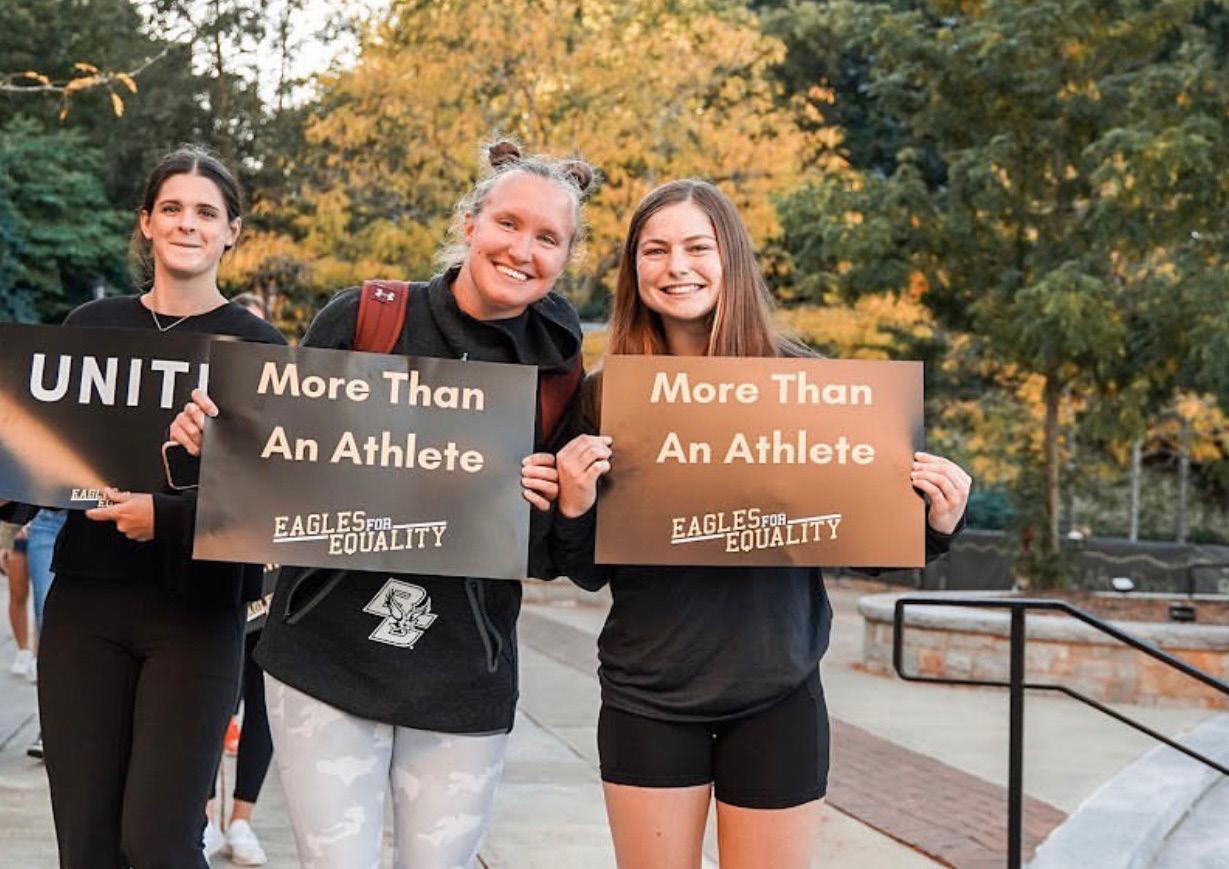

For Sullivan, being a part of Eagles for Equality is a chance to no longer play catch up, but rather, to be a leader of the pack and change others’ perspectives about what having a disability might look like.
“I think a lot of people focus on the absence of something,” Sullivan said of her disability. “I haven’t lost anything by being born deaf. It only shaped a new perspective on life. … This committee’s not just hard-of-hearing and deaf people, it’s visible and non-visible disabilities. … I’m trying to make it as general as possible.”

The disability subcommittee
is one of four subcommittees that make up Eagles for Equality. The three other subcommittees are the race and ethnicity, gender, and LGBTQ+ subcommittees.
While the group now tackles issues surrounding all four topics, the original idea for Eagles for Equality came as a response to racially motivated crimes during the summer of 2020.
“Eagles for Equality grew out of the social unrest of 2020 and the things that happened with George Floyd, Ahmaud Arbery, and Breonna Taylor,” said Michael Harris, director of student-athlete academic services. “There clearly were other challenges in terms of diversity that were happening on campus, but what prompted the group and the level of emphasis placed on diversity at that time was the current events.”
Eagles for Equality started as a subcommittee of the Student-Athlete Advisory Committee (SAAC), according to Harris.
“In the summer of 2020, we didn’t have an athletic director at that point in time,” Harris said. “We realized that we needed a vehicle for our students to be the change that they talked about—to be a part of social justice and to also keep diversity and inclusion a part of our DNA.”
With that mission in mind, Eagles for Equality began to separate from SAAC, Harris said.
Part of the group’s long-term plan was to become an officially recognized student group on campus, which would provide the students involved with more independence in the group’s activities and less oversight from the athletics department.
Jewel Strawberry, a former BC volleyball player and BC ’22, was the chair of SAAC’s diversity and inclusion subcommittee when Eagles

for Equality was first introduced. Strawberry became Eagles for Equality’s president when it broke away from SAAC, a transition that came naturally, according to Harris.
“I think Jewel did a really good job of bringing people together, being the face of the organization,” Harris said. “2020 … was a really difficult year, politics were pretty high, tensions were high, and I think Jewel did a really good job of having others at the table, making sure others’ voices were heard as we navigated some of those challenges as an athletics department.”
While Eagles for Equality centers its conversations around student voices, Harris said that as an administrator, his responsibility is to make sure student-athletes are educated on the issues they take a stance on and understand the different perspectives behind them.
NCAA and ACC.
“We do want student-athletes to take initiative,” Harris said. “We see it as a group where our student-athletes can participate and be a part of something greater than just athletics. My role is really to create synergies and collaborations across campus and to make sure that we’re in alignment with BC as an institution.”
The surge of the Black Lives Matter movement as a result of racially motivated crimes during the summer of 2020 encouraged Sydney Moore, a member of BC women’s soccer and the current president of Eagles for Equality, to become involved with DEI advocacy.
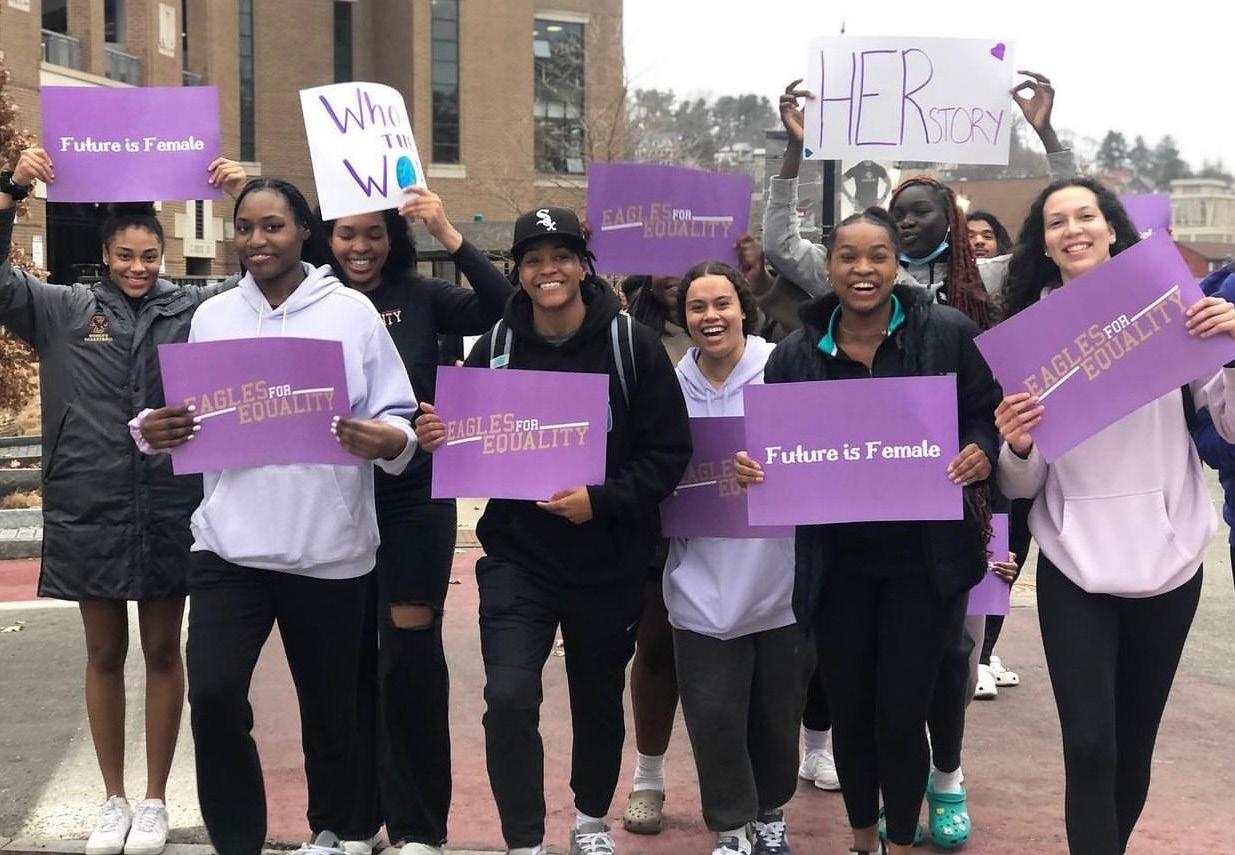
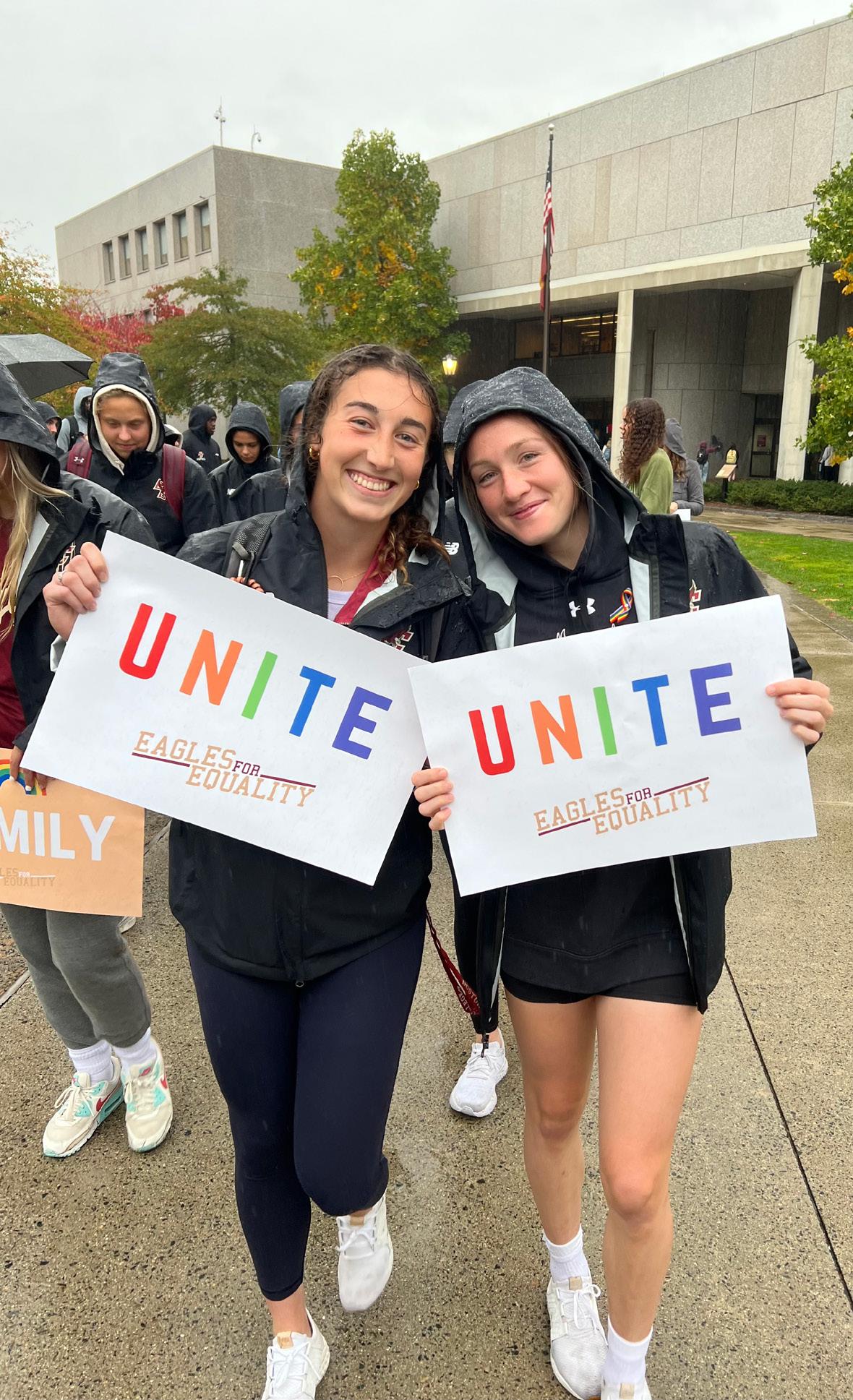
She said the mission of Eagles for
the experiences of individuals with those identities. The group also does community outreach.
“I do think that it can be challenging to be a student of color,” Moore said. “I feel like we have resources, but I don’t know how supported they are. I do feel like every year we brag about the amount of students of color we’re bringing in, but I don’t know that we’re fully supporting them to the best of our abilities.”
For Maria Gakdeng, a member of Boston College women’s basketball and the leader of the race and ethnicity subcommittee, being in a community with student-athletes of color uplifts her. But it doesn’t stop her from observing the challenges student-athletes of color face, she said.
“I feel like there’s a community of us here,” Gakdeng said. “We all come together and kind of form friendships, form bonds, through something that we all go through together. Whether it’s good or bad, we all find a way to talk about it with each other. So I think that there’s … a good community here for student-athletes of color, and I kind of embrace that.”

Gakdeng said she believes there are available resources that help build community at BC.
Equality is to not only be a support system for student-athletes with marginalized identities, but to also educate and spread awareness about
“I think Boston College is a little bit challenging for student-athletes, especially because I feel like there’s a little disconnect between athletes of color and just regular students of color,” Gakdeng said. “BC [gives] us resources where we can come together, but I feel like overall it is a bit challenging to get used to the experience here.”
Sullivan said she’s experienced a number of roadblocks in terms of accessibility since becoming a student-athlete. When Sullivan sustained a foot injury her freshman year, she was sent to Newton-Wellesley Hospital to receive an MRI, where she learned that the MRI’s magnetic capabilities would interfere with her cochlear implant. Sullivan couldn’t participate in the scan, and as a result, she was
“I actually have a different experience where my head coach is Black, which kind of provides some support,” Moore said. “It’s the person who’s in power on your team.”
Gakdeng said that her identities as a female athlete and an athlete of color intersect, which makes her experience as a student-athlete especially unique.
“Being a student female athlete of color is kind of a different experience because there’s so many intersections of where I come from, and it just makes my experience especially specific because I have a different experience than most other people here,” Gakdeng said.
While Gakdeng has confided in other female athletes of color, she said she wishes she was connected with more Black women outside of the athletics department.
Sullivan has also participated in discussions surrounding disability advocacy outside of the athletics community. The Undergraduate Government of BC’s Council for Students with Disabilities hosted a talk in February featuring Abigail Heringer, the first deaf contestant on The Bachelor
Gakdeng said she hopes Eagles for Equality will collaborate with other student groups and non-athletes on campus in the future.
“Going into the spring semester, we’re looking to join with other student groups on campus and … not just let it be student-athletes but the whole student body—invite everyone,” Gakdeng said. “Last school year, we did a picnic for the end of the school year where … all students were welcome, so I feel like that was a good way to welcome people outside of the athletic community to learn more about us.”
Moore said she has similar goals.
“A lot of the time at our events we see the same faces,” Moore said. “I hope that we can reach other sports that aren’t as involved, but also I hope that we can reach the general population of students at BC. A lot of our events are open to everyone on campus, which I don’t think a lot of people are aware of.”

For Sullivan, the future of the disability subcommittee is filled with opportunity.
sidelined from track for four months while she was unable to properly receive a diagnosis.
At the same time, Sullivan said she’s also had experiences where University accommodations have improved her quality of life. During the COVID-19 pandemic, maskwearing made it difficult for Sullivan to communicate with others, as she relies on lip reading, she said. But thanks to BC’s accommodations, Sullivan could still participate in the classroom setting.
“BC was very supportive with me,” Sullivan said. “Sometimes they would have the professors wear a clear mask so I can lip read. And they would wear an additional device—it’s called a microphone—that connects to my implant, so that would help me hear better.”
Being an athlete of color on a predominantly white team can feel isolating, Moore said. Moore said that she has benefited from playing for head coach Jason Lowe, who is Black.
“I was like ‘Wow, okay, I want to go to that,’” Sullivan said. “Truly, I think Boston College, the fact that they gave me the opportunity to talk to this kind of role model—someone that’s older than me with a cochlear implant—that was kind of the turning point for me. It kind of changed my perspective on my disability.”
After her conversation with Heringer, Sullivan had the motivation to increase her involvement in disability advocacy and create the disability subcommittee of Eagles for Equality. With a new understanding of her disability—that being deaf has offered her a new perspective on life—Sullivan said she’s felt more comfortable sharing her story with others and does so more often now.
“It’s a brand new committee,” Sullivan said. “Right now the biggest accomplishment is we are striving to invite this Paralympian to come to speak at BC. I think that it is going to be super, super cool for student-athletes to hear her story and be inspired by her story.”
As she looks ahead to what comes next for Eagles for Equality, she’s far from playing catch up. Rather, Sullivan—like Moore and Gakdeng—is one of the few student-athletes on campus leading the movement to
ensure that BC prioritized DEI.
“It’s a little nerve-wracking for me, just because it’s so new, but I also think it gives me the opportunity for my members and I to create it how we want it,” Sullivan said. “Boston College’s motto is men and women for others, and I believe our group reflects that.” n
Graham Dietz contributed to reporting.

Boston College women’s basketball has asked a lot from freshman Taina Mair through the first five games of the season.
Head coach Joanna Bernabei-McNamee tasked Mair with commanding the floor, and the young guard played all but seven minutes of BC’s first four games of the season entering the Eagles’ Sunday afternoon game against Providence (3–2).
In the opening minutes of BC’s 73–64 win over the Friars, Mair demonstrated why Bernabei-McNamee believes she’s capable of filling such a demanding role.

“I’m definitely learning,” Mair said. “Especially how to be a leader, especially
being a freshman taking on that role.”
Propelled by Mair’s blazing pace, the Eagles (3–2) needed just two minutes to race out to an 8–0 lead. Mair chipped in a 3-pointer and dished out an assist, while BC crashed the glass effectively.
From there, Providence showed Mair the challenges of playing floor general so early in her career. The Friars forced Mair to navigate through double-teams and blinding pressure, stripping the ball from her twice in the span of 20 seconds.
Providence capitalized, as the Eagles went cold, tying the game up at 10 points apiece late in the first period. Eight of those 10 points came off BC turnovers.
“[Mair] was a major focus of what Providence was doing defensively,” Bernabei-McNamee said. “They were tracking her on ball screens, and they were picking her up full-court.”
With the score tied at 14, the opening
minutes of the second quarter played out similarly to the initial minutes of the first. BC’s defense forced the Friars into contested jumpers, while the Eagles’ offense detonated. A 19–3 run pushed BC’s lead up to 14.
During the run, freshman Kayla Lezama recorded her first career points, converting on a tough reverse layup and the and-one free-throw that followed.
Mair again found herself in the middle of the action, leading the way with a team-high eight points and three assists near the game’s midway point. Unlike in the first quarter, BC maintained its intensity and took a 10-point lead into the locker room at halftime.
“I think [the difference was] just staying engaged on defense and stopping the ball and paying attention to kind of the details,” T’Yana Todd said.
The Eagles survived every punch
BC won back-to-back games for the first time this season, improving to 3–2.
Providence threw in the third quarter and carried a double-digit lead into the game’s final 10 minutes. BC entered the final quarter up 55–44.
Though the two teams played much of the fourth quarter separated by single digits, the Friars failed to ever seriously challenge BC’s lead.
With the game winding down to its last seconds, it was fitting that Mair—
who celebrated her 19th birthday on Sunday with family sitting courtside— dribbled out the clock. The freshman, who led the nation in assists entering the game, bore the brunt of the scoring responsibility with a career-high 15 points.
“It was a great feeling,” Mair said. “I mean, after the game just going to see my family and everybody just cheering me on—it’s a great feeling." n

Rivalries are innate to college football’s nature, and the so-called “Holy War” is one of college football’s oldest rivalries.
Past moments from the “Holy War” make up parts of Boston College football’s identity, partly because there are bigger things at stake when BC and Notre Dame suit up to play one another: shared Catholic values.
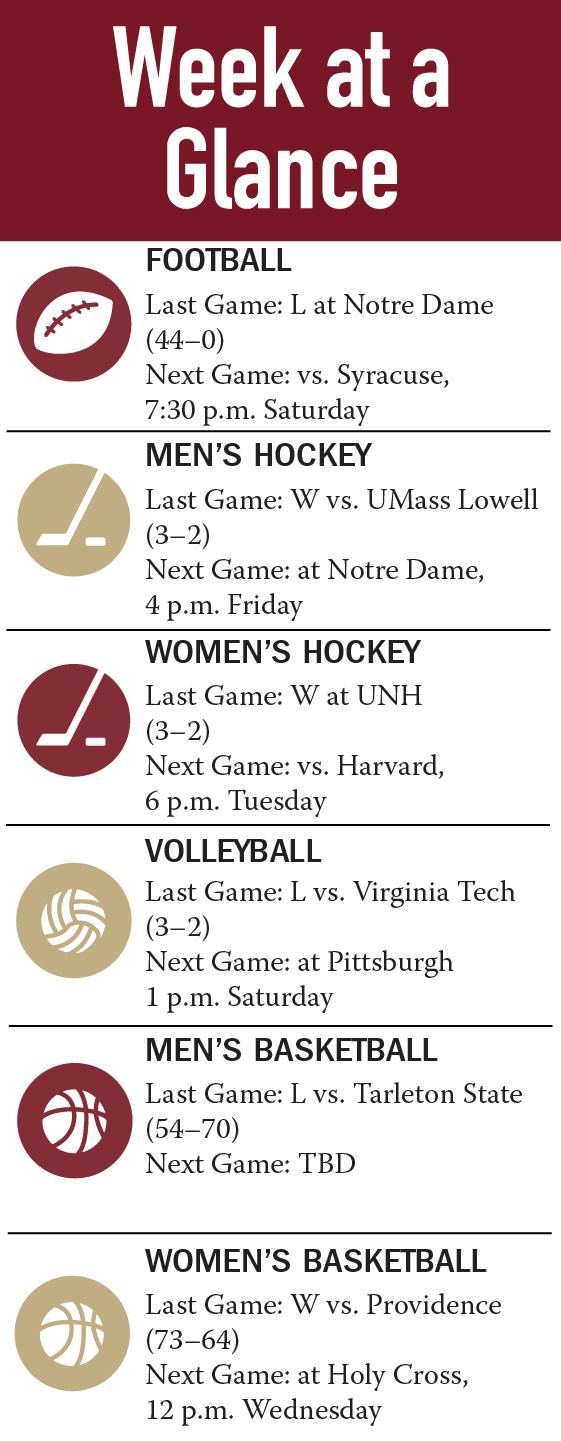
But the schools’ shared religiosity hasn’t stopped the Fighting Irish from beating up on BC, which hasn’t defeated Notre Dame since 2008.
Prior to Saturday’s game, Notre Dame had won 27 straight regular-season games against ACC opponents.
On Saturday, the Fighting Irish (8–3) extended that streak when they hosted the Eagles, who came into South Bend after snapping a streak of their own—beating a ranked opponent for the first time in eight years. Building off its 37–0 firsthalf lead, Notre Dame coasted to a 44–0 victory over BC (3–8, 2–5 Atlantic Coast) in redshirt freshman Emmett Morehead’s
third career start.
“I don’t think it was for a lack of effort,” head coach Jeff Hafley said after the game. “We had a bunch of guys who didn’t practice all week and came out and gave everything they had. That is not an excuse of why we did not win this football game, but I appreciate their effort.”
On the first play of the game, Logan Diggs broke through a seam for a gain of 51 yards.
Notre Dame had a third-and-6 later on the same drive. As quarterback Drew Pyne dropped cleanly in the pocket, BC forced him to scramble to his right with Bryce Steele in pursuit. Pyne threw an incomplete pass into man-to-man coverage, and the Eagles limited the Fighting Irish to a 26-yard field goal attempt, which Blake Grupe successfully converted.
On its next six offensive drives—all of which came in the first half—Notre Dame registered 34 points, and for the second time in school history, the Fighting Irish scored 35 points or more in five-straight games.
“I thought Notre Dame was the biggest offensive line we played all year,” Hafley said. “I’m not sure it was just physicality.
I thought they did some things that we missed fit. We missed some tackles, but certainly a really big O-line and big backs.”
Jaelen Gill took the first BC kick return 42 yards to BC’s 48-yard line, but a holding penalty forced the Eagles all the way back to their 13-yard line.
From there, Notre Dame’s true freshman cornerback Benjamin Morrison took over.
After Morehead threw two incompletions on the Eagles’ first two offensive plays of the game, the signal caller out of Woodside, Calif. tossed a ball up in the air for Joseph Griffin Jr. Morrison jumped the route, recording his first interception of the game.
“I just felt like we never got into a rhythm,” Hafley said. “Obviously in that second half, you couldn’t throw. The football was hard enough to throw in the first half, and then in the second, I don’t know if you could even see what was going on [from the broadcast]. It was hard to see from the sidelines.”
By the end of the game, Morrison had three interceptions, becoming the first Notre Dame player to record three interceptions in a single game since 2010,
when now-Minnesota Vikings pro bowler Harrison Smith did.
Diggs began to eat up BC’s interior defense, and offensive coordinator Mike Sanford kept feeding him. After Diggs took carries of 5 yards, 9 yards, and 4 yards, the Fighting Irish were two yards away from punching in their first touchdown of the game.
Notre Dame was unsuccessful on the next play, but Diggs finally stepped into the end zone from the 1-yard line, putting Notre Dame up 10–0. For the rest of the game, Diggs showcased his elusiveness, accumulating 122 yards and one touchdown from the ground.
The scoring spree never came to a halt for the Fighting Irish, thanks in large part to Michael Mayer, Notre Dame’s star tight end and potential future first-round pick. Mayer hauled in five receptions for 64 yards in the game and was a big contributor on third down plays.
“[Mayer] was certainly a point of emphasis in the game plan,” linebacker Vinny DePalma said. “He’s as good as it gets.”
The Eagles were down 37–0 by the end of the half, and the half-time statistical comparison was one of the worst BC’s
seen all season long. Notre Dame led in net total yards 336–81, net rushing yards 214–1, and scored on all five of its redzone trips. The only category BC led was total turnovers, which the Eagles led 4–0.
On BC’s first offensive drive of the second half, heavy flurries of snow began to come down in heaps from the sky, and the “Holy War” was becoming something more akin to the “Frozen War.” The weather never got to the Fighting Irish, and the Eagles went scoreless once again.
“When we turn the ball over three times in the first quarter, four times in the first half, and five times in the game, you really don’t have a chance against a good team,” Hafley said. “You don’t have a chance against anybody.”
Despite being scoreless, Zay Flowers surpassed Alex Amidon’s 191 career receptions to become BC’s leader in receptions. Just a week after Flowers broke the school record for career receiving yards, Notre Dame held Flowers to just 46 yards on three receptions.
The only difference between the first and second half was that BC—donning allwhite uniforms—became unrecognizable on the field in the whiteout blizzard. n
Senior captain Izzy Clavenna recorded 14 kills and a .419 hit percentage, leading to an intense, five-set win over Virginia Tech Saturday.
Boston College volleyball (19–12, 7–10 Atlantic Coast) honored graduate student Kate Brennan, senior Silvia Ianeselli, and Clavenna prior to its match against Virginia Tech (11–17, 4–13) in the Eagles’ final home game of the year.
The set scores were 25–15, 19–25, 25–14, 26–28, and 15–9.
“I think they’ve been kind of the backbone,” head coach Jason Kennedy said. “I think especially later in this year we’ve relied on all three of them quite a bit.”
Entering Saturday’s game, Clavenna led BC in kills this season with 244, Brennan led the team in hit
percentage with .424, and Ianeselli had recorded double-digit kills in four of her last five games.
“Kate’s come in [and] had an immediate impact right off the bat, starting in every match for us,” Kennedy said. “Izzy has started and played in every match for us, and Silvia has come on strong late. We wouldn’t have the success we have at the end of the year here without her coming into a role where we never take her off the floor.”
The last time the Eagles and the Hokies played, the Hokies swept the Eagles 3–0.
But on Saturday, BC got off to a strong start in the first set. The Hokies had trouble returning Sophia Lambros’ serves, and she recorded back-to-back aces, helping propel the Eagles to a 9–2 lead before Virginia Tech called its first timeout.
The Eagles sealed the first-set win after an ace from Anna Murphy. After a back-and-forth exchange,
Ianeselli ended the second-set rally with a strong kill to put the Eagles up 10–7. The Hokies then went on a 7–1 run to go up 14–11 before Clavenna ended it with a kill.
But the Hokies refused to give in and took the second set 25–19.
Two powerful kills from Brennan helped the Eagles take a commanding 10–5 lead in the third set, forcing a Hokies timeout. A block from Jenna Pollock extended BC’s lead to 17–8 and forced Virginia Tech to call yet another timeout, and a service error from the Hokies gave the Eagles a win in the third set.
With the Hokies leading 13–7 in the fourth set, Clavenna shifted the momentum with a major kill to cut the lead to five, and the Eagles rallied around it. Two more Clavenna kills cut the Hokies’ lead to two.
Virginia Tech fought back for a 22–14 lead, but the Eagles came all the way back to tie the set at 24 apiece.
Clavenna sent a rocket off of the head of Virginia Tech’s Sierra Cates to tie the set at 26, but the Hokies squeaked out the fourth-set win.
“They could have folded when it was 20–12 or whatever it was, and instead they came back—they fought all the way back,” Kennedy said. “If we don’t make that run, it’s heartbreaking to lose a set like that, but if you don’t make that run, they have all the momentum going into the fifth.”
The intensity of the fourth set carried over into the fifth, and BC kept its foot on the gas to solidify a victory with a kill from Brennan.
Brennan finished the match with 12 kills and a .688 hit percentage.
“We had to serve tough,” Kennedy said. “It took us a little bit to find our rhythm in the second set. … We came out with our hair on fire, and eventually, I think we settled into the fifth set. I think our serving is really what won us that set." n